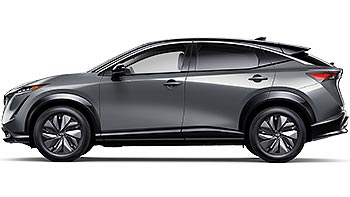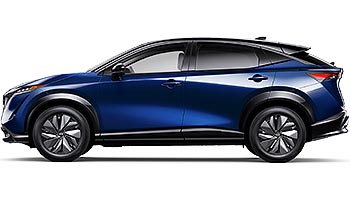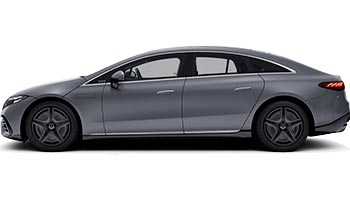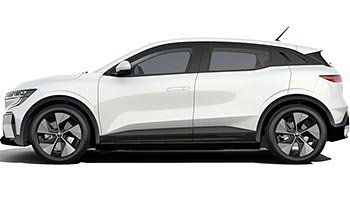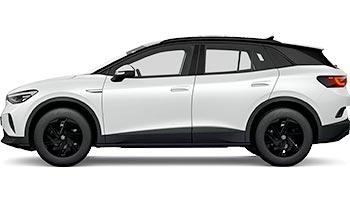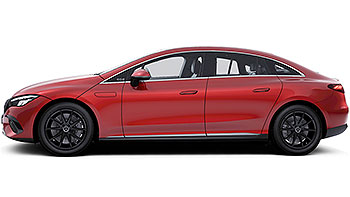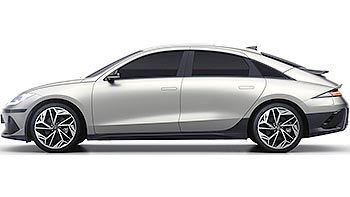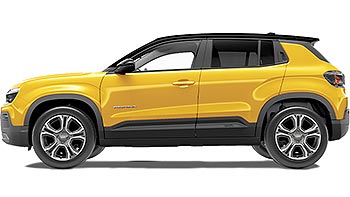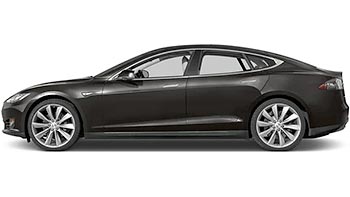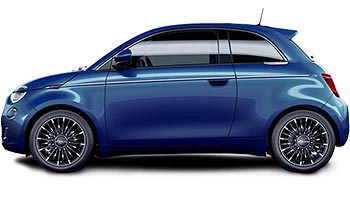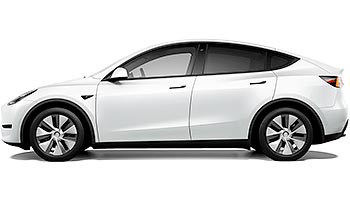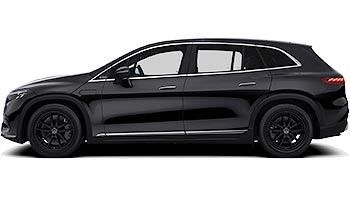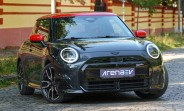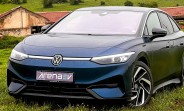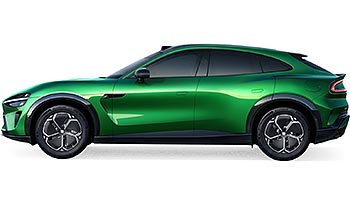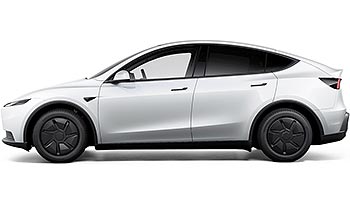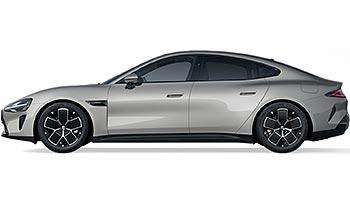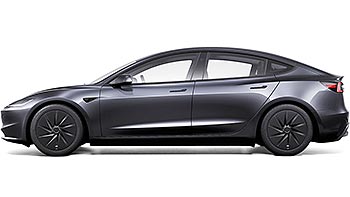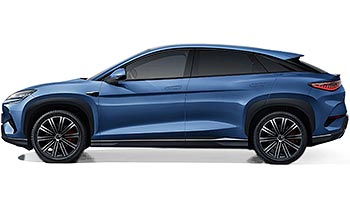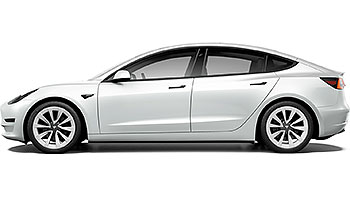Nissan Ariya review

Nissan came out with the Ariya almost three years ago, but for a good while it struggled to ramp up production and deliver enough cars. Now, it looks like these problems are finally going away and buyers all around the world can start enjoying Nissan’s first electric crossover without having to wait months for delivery.
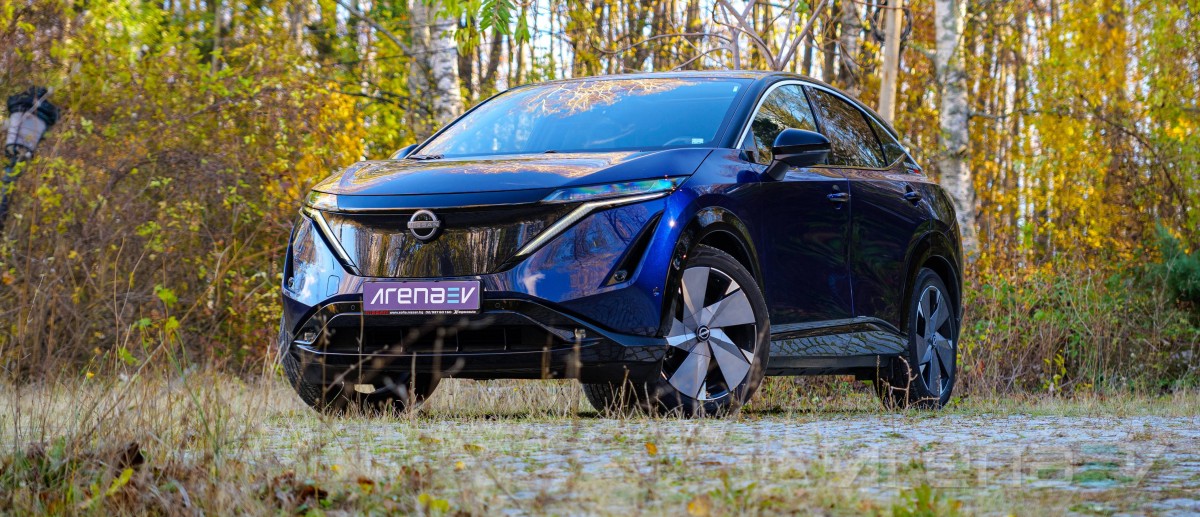
Table of Contents:
- Exterior
- Interior
- Storage & practicalities
- Driving experience
- Tech features
- Ride comfort
- Cabin noise
- Acceleration and braking
- Consumption
- Charging speed
- Competition
- Verdict
The Ariya shares the CMF-EV platform with the Renault Megane E-Tech, but the two cars are completely different and offer distinct driving experiences. The Nissan Ariya is a larger vehicle with more interior space and a luxurious interior that aims at higher market segments. In fact the base Ariya costs more than the most expensive Megane version, so there's no overall between the two.
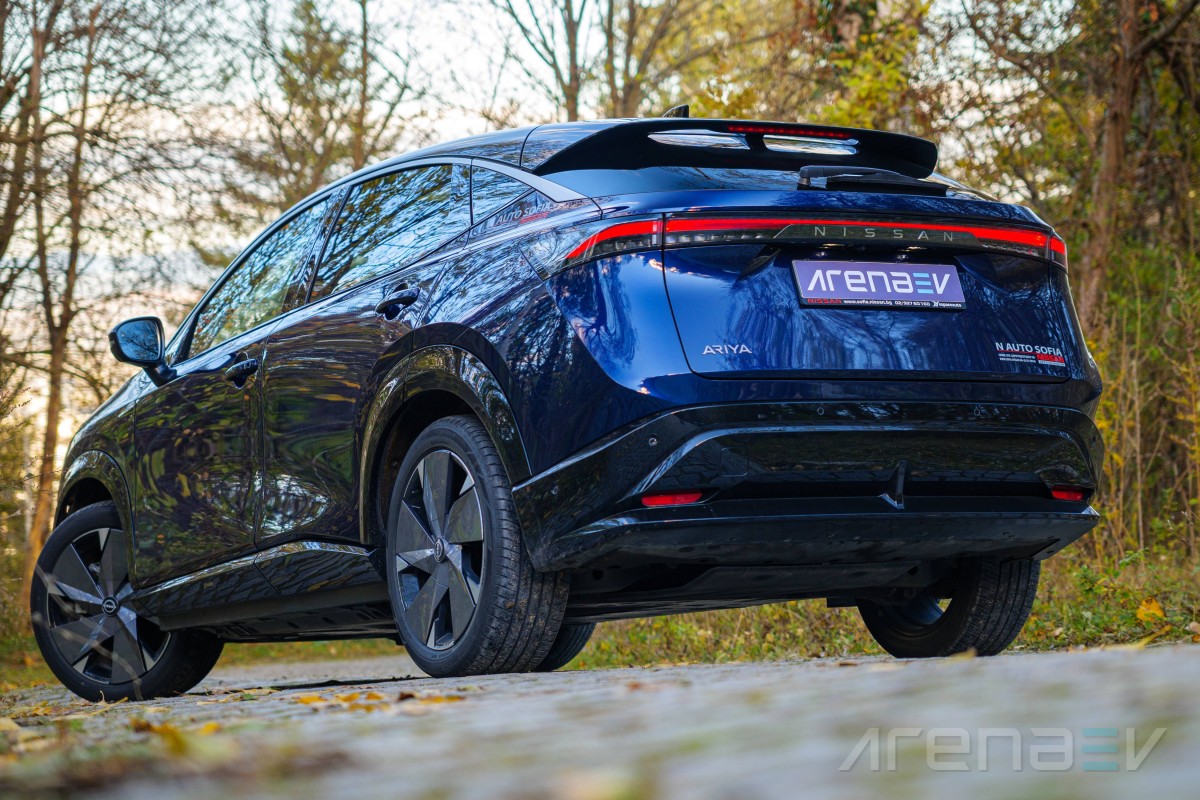
The Ariya comes with 160 kW (218 hp) power output in its base FWD version with a 63 kWh battery and goes all the way to a 290 kW (389 hp) AWD variant called the e-4ORCE Evolve+, which comes with a bigger 87 kWh battery.

Our test model has the 87 kWh battery, but a single motor with FWD, meaning it's the one with the greatest efficiency and longest range. It's also featuring the highest available trim - “Evolve”, with an optional two-tone metallic paint job, 20-inch alloy wheels and blue leather seats. These options bring the final price to the rather $80,800.
- Dimensions: 180.9 inches x 72.8 inches x 65.4 inches, 109.3 inches wheelbase.
- Drivetrain tested: 87 kWh - FWD 178 kW (242 hp), 221 lb-ft, 87 kWh usable battery capacity; 90 kWh total battery capacity.
- Other drivetrains: Pro - FWD, 160 kW (218 hp), 221 lb-ft, 63 kWh usable battery capacity; 65 kWh total battery capacity.
- Charging: 130 kW CCS; 20-80% in 30 min.
- Range: 333 miles WLTP (304 miles EPA)
- Weight: 4,676 lb unladen; 5,578 lb gross
- Other features: Hidden storage, Movable center console, OTA updates, Augmented reality head-up.
Exterior
Nissan went with a very futuristic design for the Ariya, which is very easy on the eyes. The exterior is very angular and everything but the tires looks as though it can cut you. The design matches the rest of the current Nissan lineup, which makes it instantly recognizable as part of the Japanese brand, yet it's different enough that it doesn’t get mistaken for some of the other models.
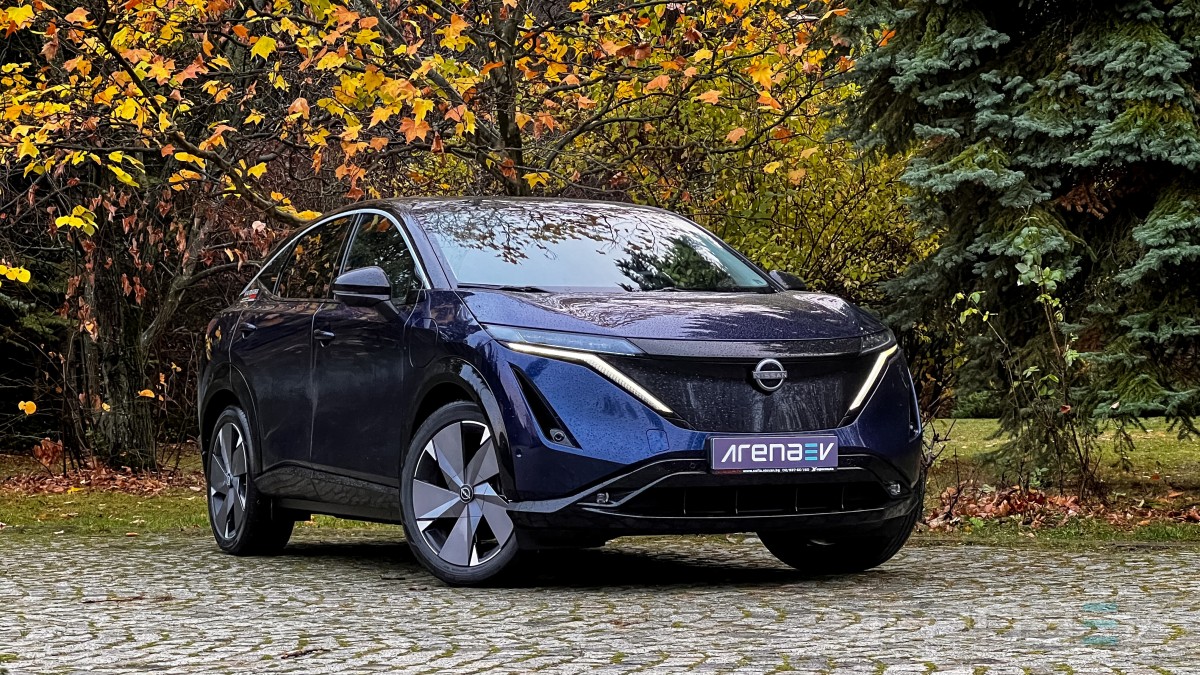
The front of the Ariya features a big black plastic element, reminiscent of a grille. Since this is an electric vehicle, it doesn’t need a traditional grille and so Nissan made the giant plastic panel funkier with design elements that fade away into the center, mimicking lanterns from the traditional Japanese culture.
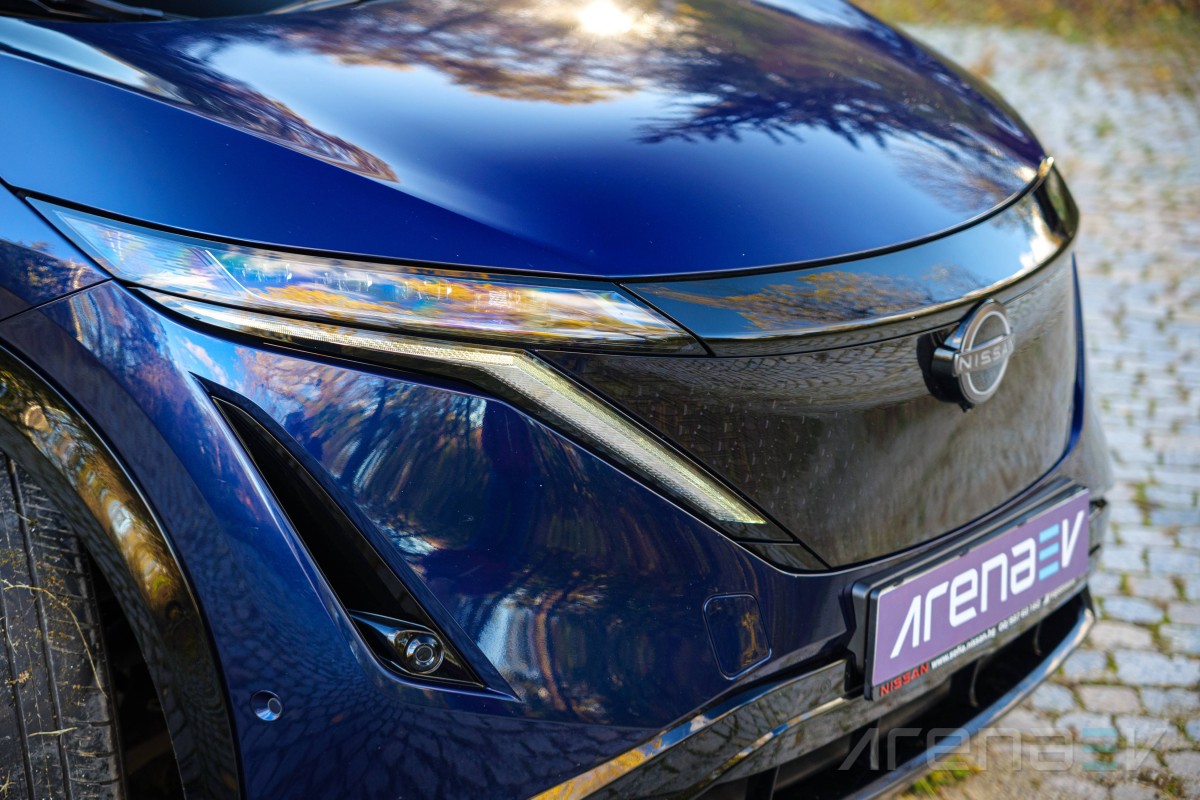
The other most noticeable element up front are the giant headlights, with their running lights part piercing down and into the center, creating a unique and sinister look.
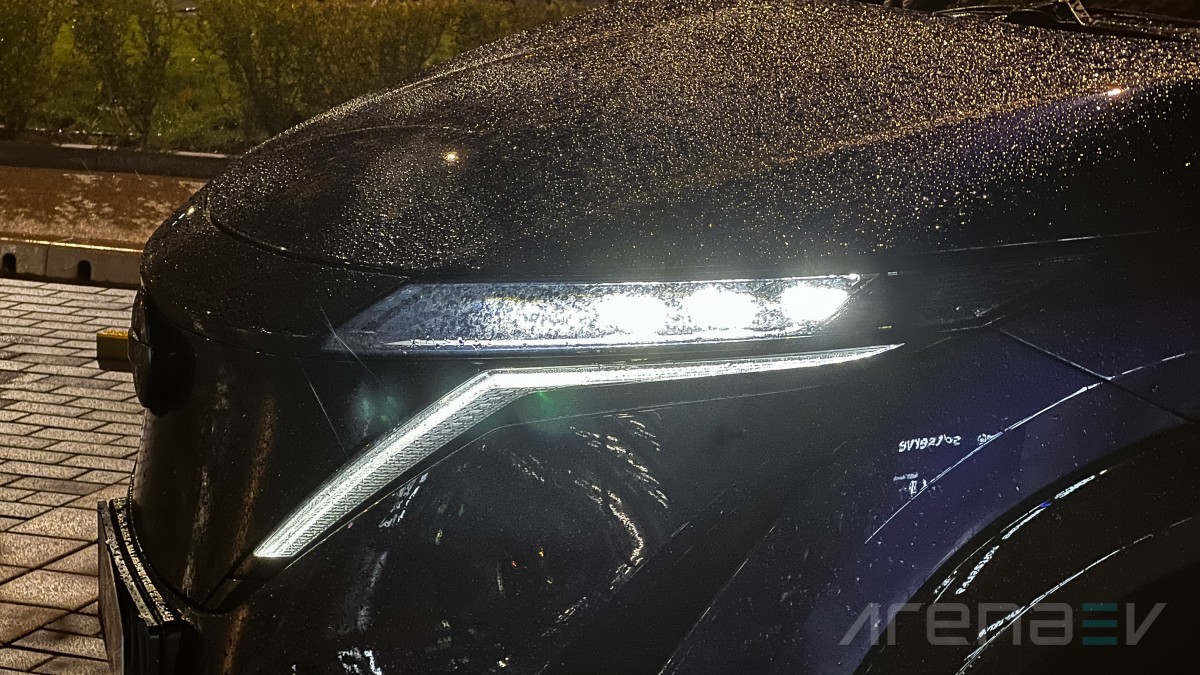
There is an actual grille further down that helps cool down the batteries - it is finished in black for all models, making the Ariya look more off-roady and rugged. This theme continues all around the exterior, creating the perception of a much bigger vehicle, even if the Ariya is a relatively compact crossover.
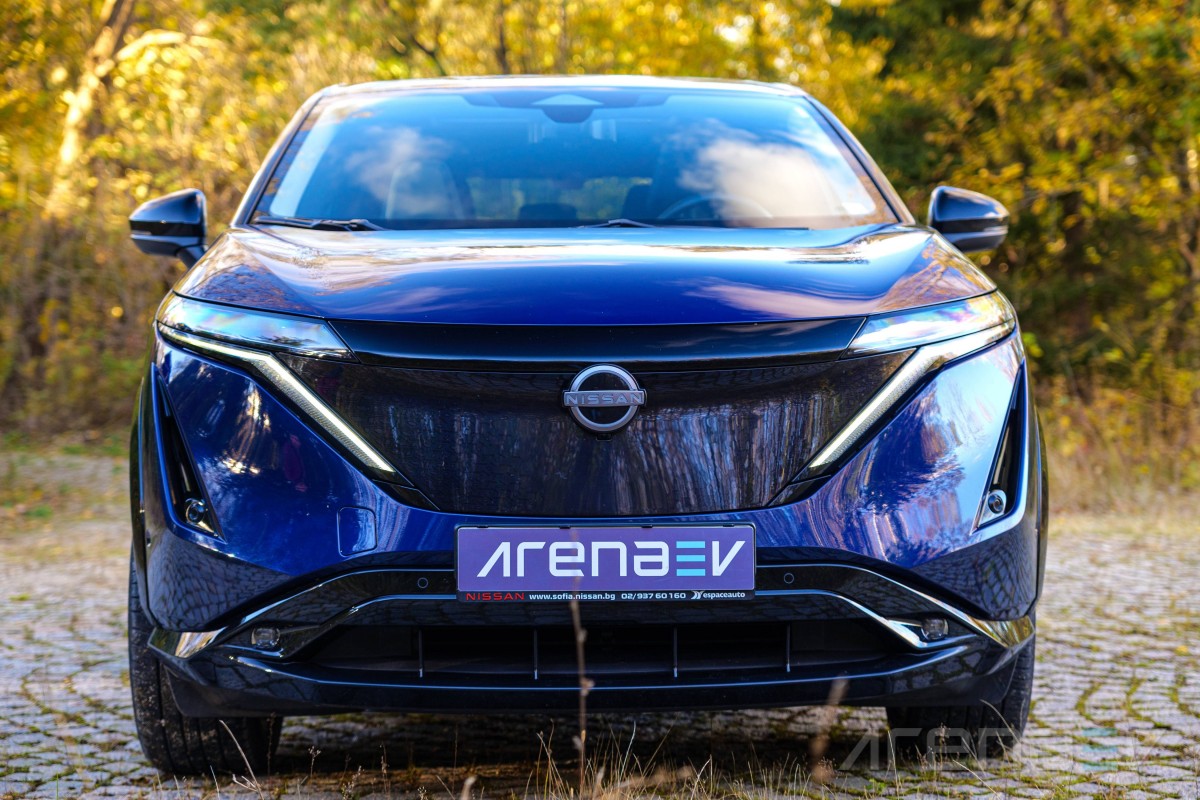
The side of the Ariya features no surprises, except for the optional two-tone paint, which creates the illusion that the roofline is “floating” and the car is lower than it actually is.
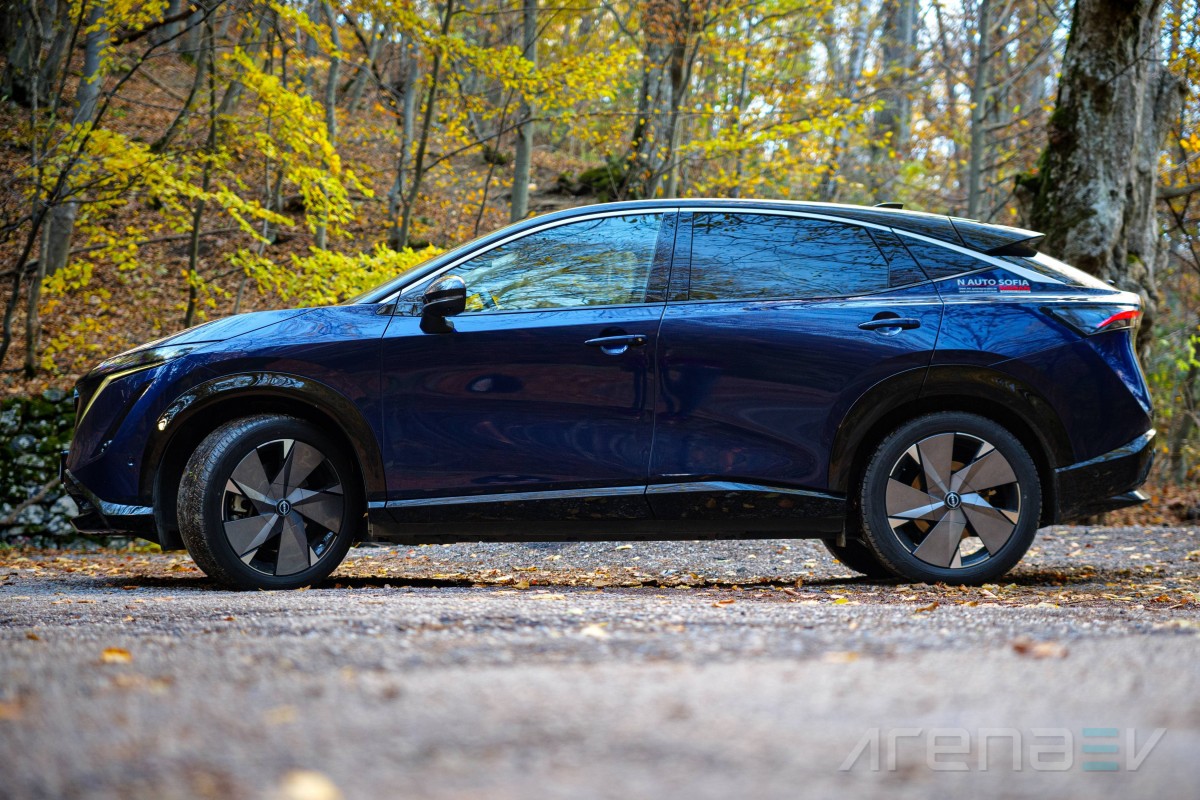
We measured the ground clearance of the Nissan Ariya is 6.9 inches, which is a little lower than the ((185 mm}} that the manufacturer claims. It's still decent for going over speed bumps and even low kerbs if the need arises.
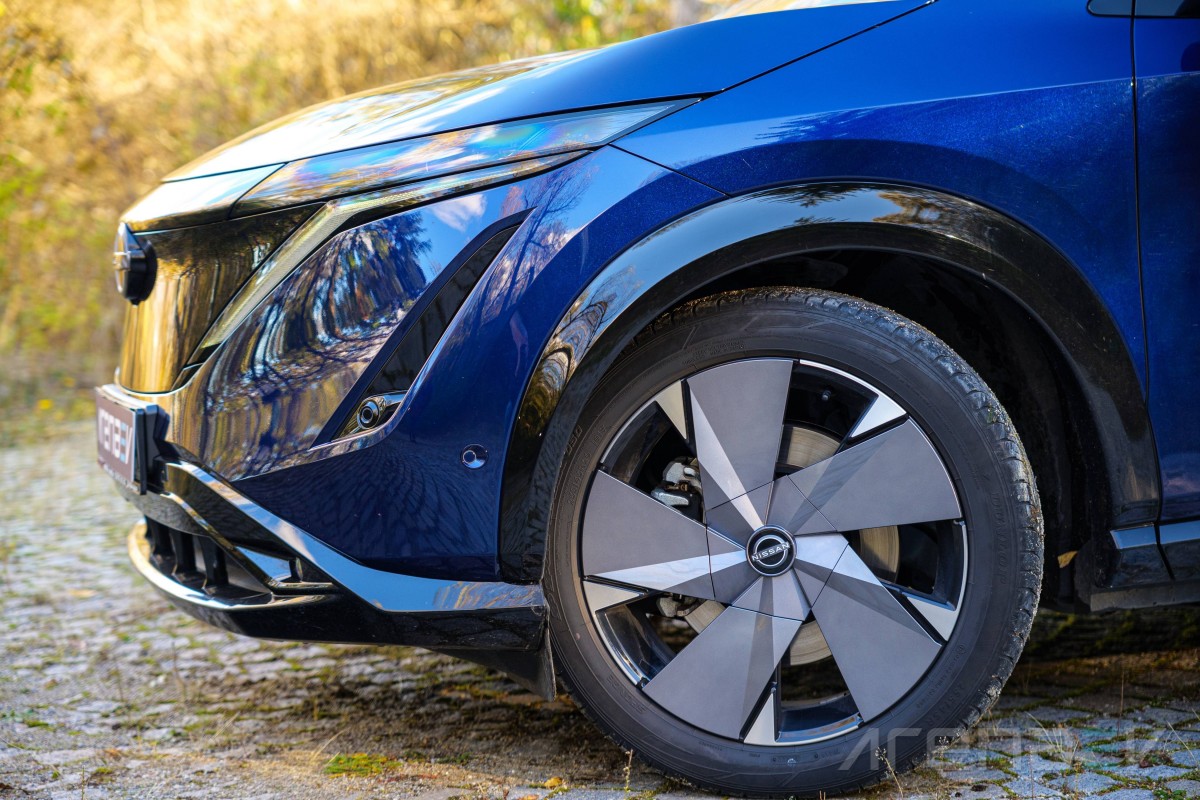
The wheels on our test car were the optional 20-inch ones with a twisted 5-spoke design. They are equipped with Dunlop SP Sport Maxx 050 in size 255/45/R20, which are sport summer tires that prioritize grip over efficiency.
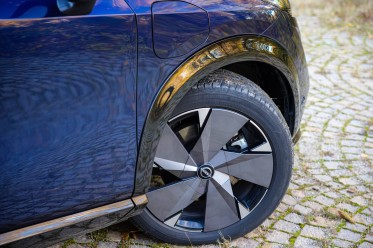
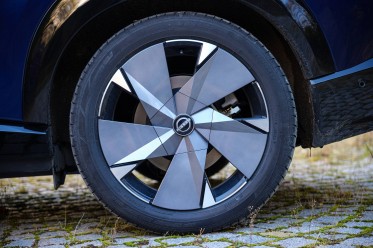
The Dunlop tires we had prioritize grip over efficiency, which is a trade you should really consider when equipping your Ariya.
The rear end is Nissan Ariya’s most distinguishing part. It is characterized by many hard edges and lack of a traditional logo, which has been replaced by letters, spelling out “Nissan”.
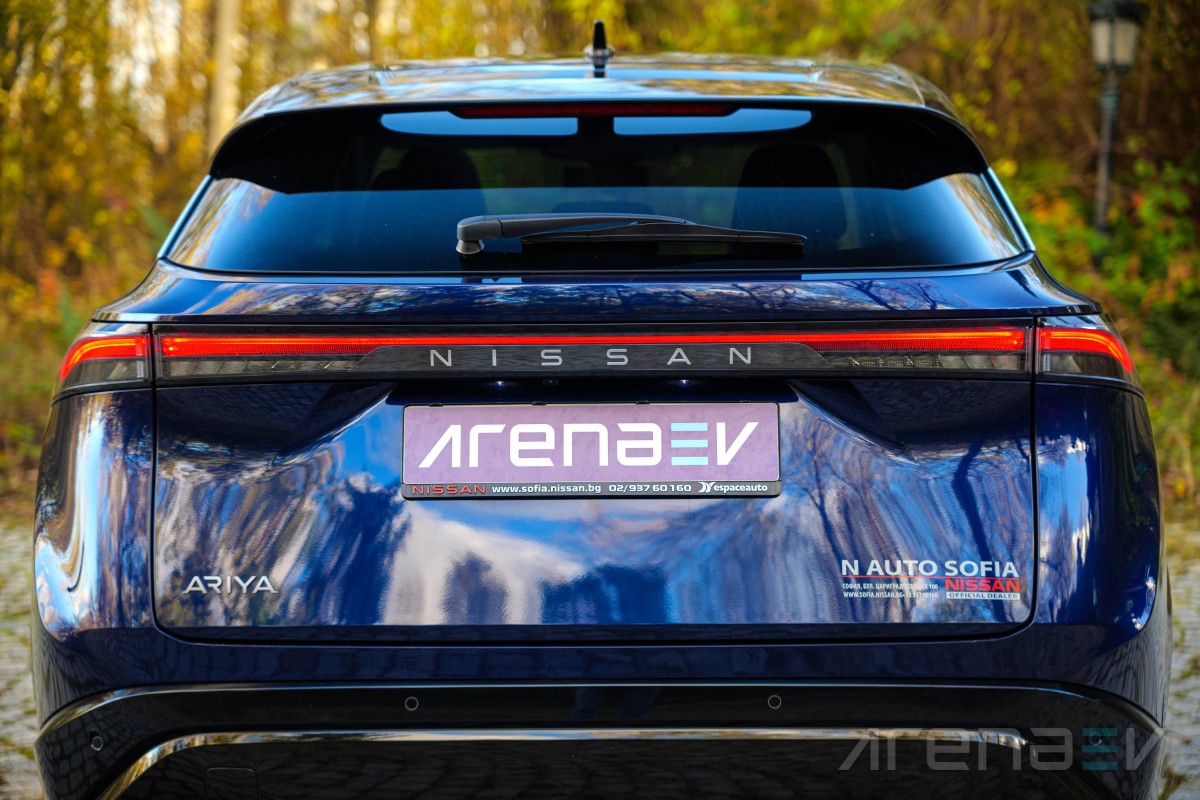
A giant LED bar goes from end to end, incorporating the taillights. Its light signature stands out from the many other new models with a single taillight bar that came out recently. The taillight is high in the center and gradually slopes down with a steep curve on each end.

There is also a big spoiler that finishes the rear end design and makes the whole vehicle feel complete with its sleek integration.
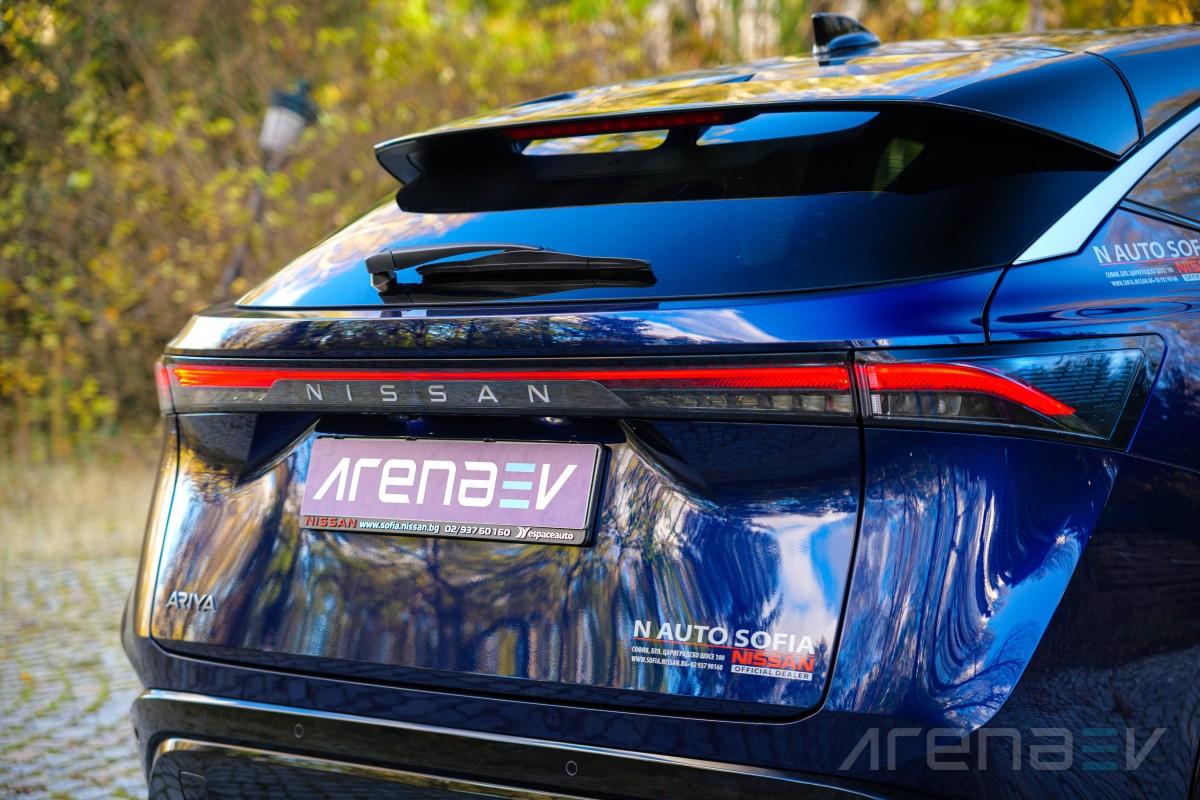
Interior
The inside of the Ariya is truly impresive. Our test model had the optional blue leather interior, which may not be everyone's cup of tea, but it makes for a cozy atmosphere and distinguishes the vehicle from its competitors. The alcantara on virtually the whole dashboard and nice wooden accents finish the premium setting.

As you open the driver’s door you discover the immaculate attention to detail, as Nissan has once again integrated the traditional Japanese lantern design, this time also using it as mood lighting. It looks spectacular as you enter at night and even just looking at it during the day.
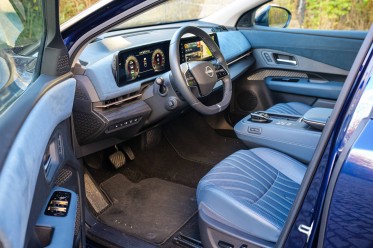
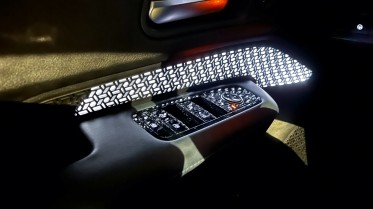
The Ariya has immaculate attention to detail.
The cushy seats are very relaxing and incite no rush. They can be adjusted in multiple ways and even offer heating and ventilation in the Evolve trim.
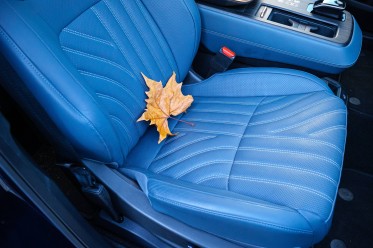
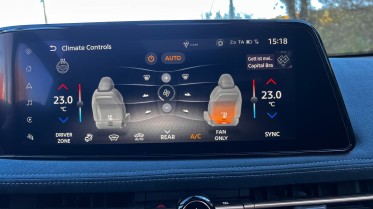
The seats in the Ariya prioritize comfort over sportiness, understandable for a family crossover.
Then, when you’re comfortably seated, you reach for the steering wheel, which is directly borrowed from the lightweight sports coupe Nissan Z, except here it has lost the spoke on the lower part and the sporty feeling that came with it. We have one small gripe with the wheel - Nissan decided to include a centered wheel mark as some sports cars have, but then placed it on the bottom, rather than the top of the wheel, where it looks out of place.
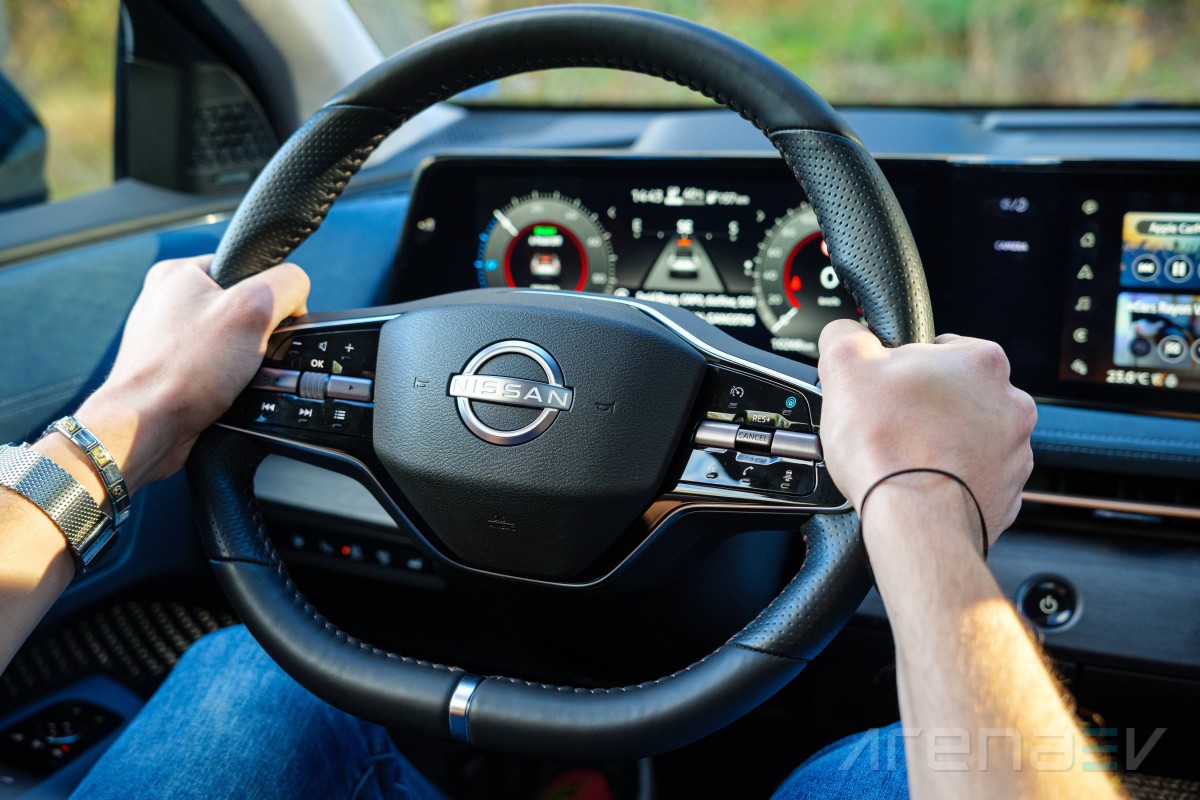
The 12.3" gauge cluster display behind the steering wheel measures 12.3 inches can be extensively customized to show you exactly the information you need. An interesting quirk is that you have a brightness button to the left of the screen, which shows many different stages of brightness, but none of them make much difference, except for the final one, where all lights in the interior pop out much more noticeably.
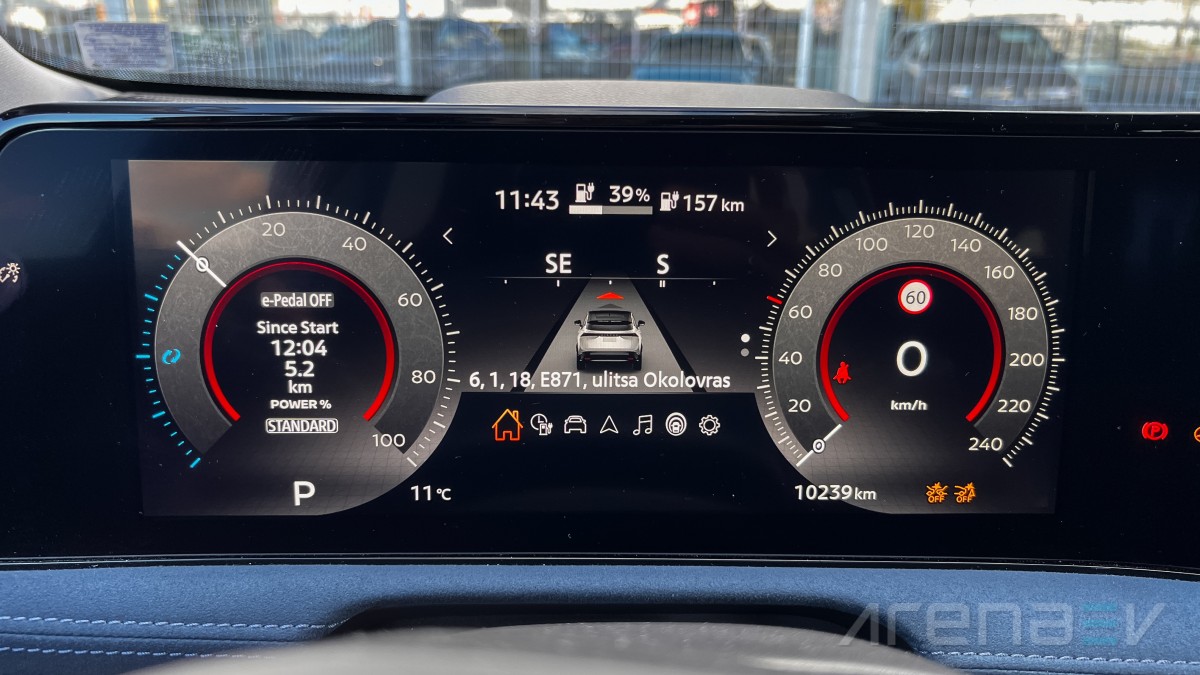
Above the gauge cluster display we find a great head-up display unit, which has augmented reality features and has great integration with the navigation system.
Moving on to the center, we find a second 12.3-inch display with touchscreen, which is also well integrated with the gauge cluster. Sadly, it has a lot of lag, which makes operating it a tedious task.
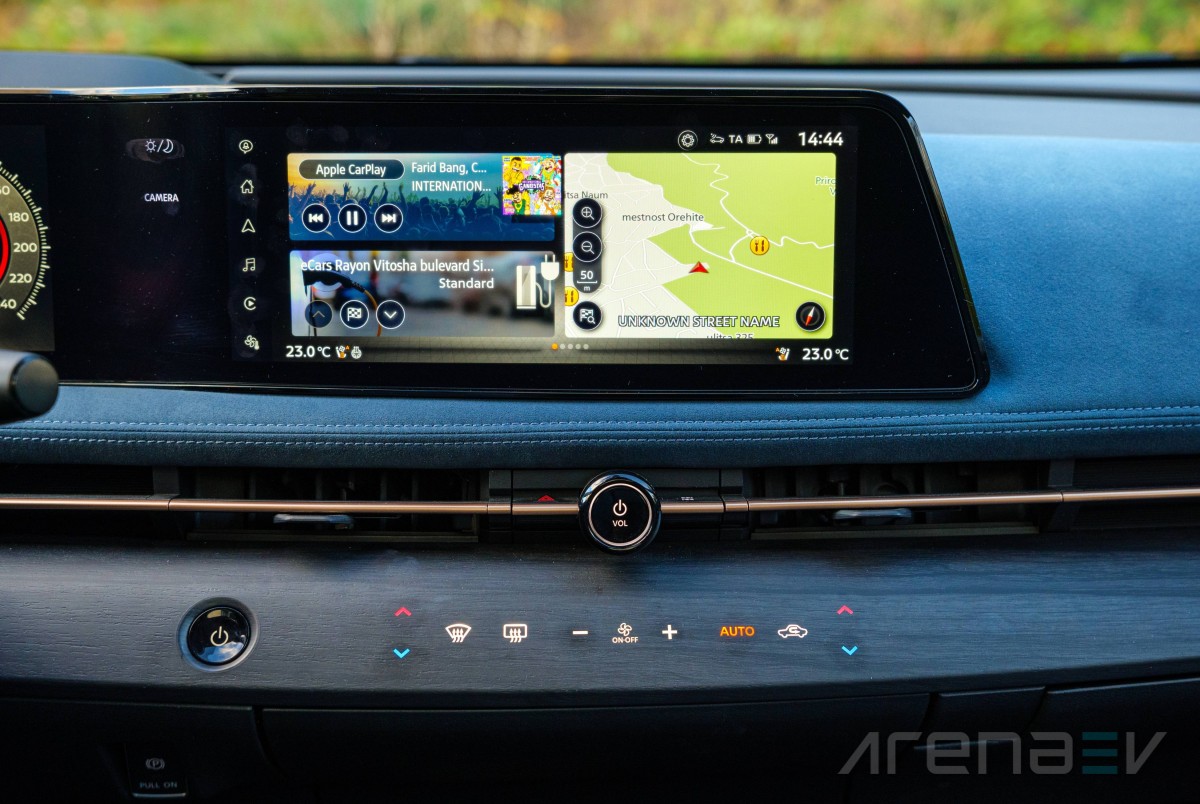
Below the center screen you find the button for turning on and off the system - a beautiful polished big knob, which is the focal point of the whole interior. Beside it is the hazard lights button and the next track button, which along with the A/C vents are all integrated into a single big unit, stretching all the way through the center console. It is a great piece of design that fits seamlessly with the rest of the interior, creating a more premium setting.
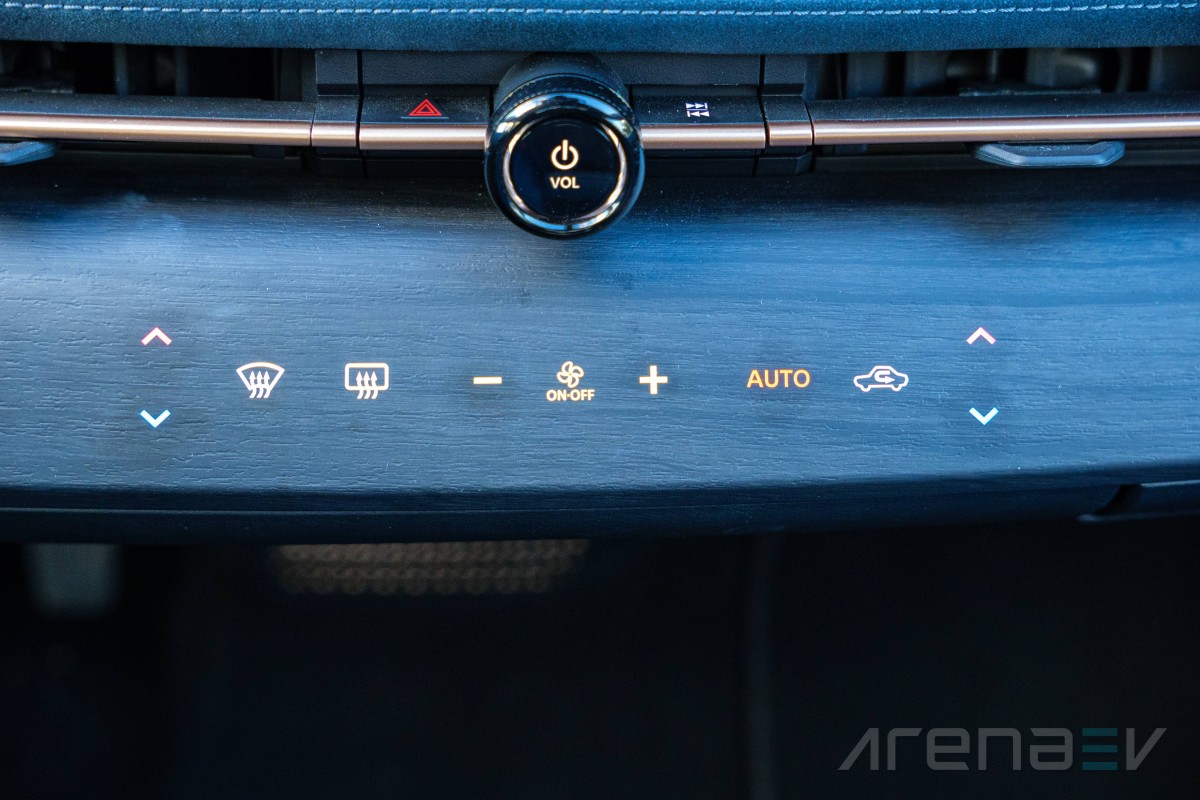
Another amazing mix of technology and design is just below the vents, where we see a big wooden piece, stretching once again from end to end in the interior. It incorporates the climate control buttons, which not only looks amazing, but is also very easy to use.
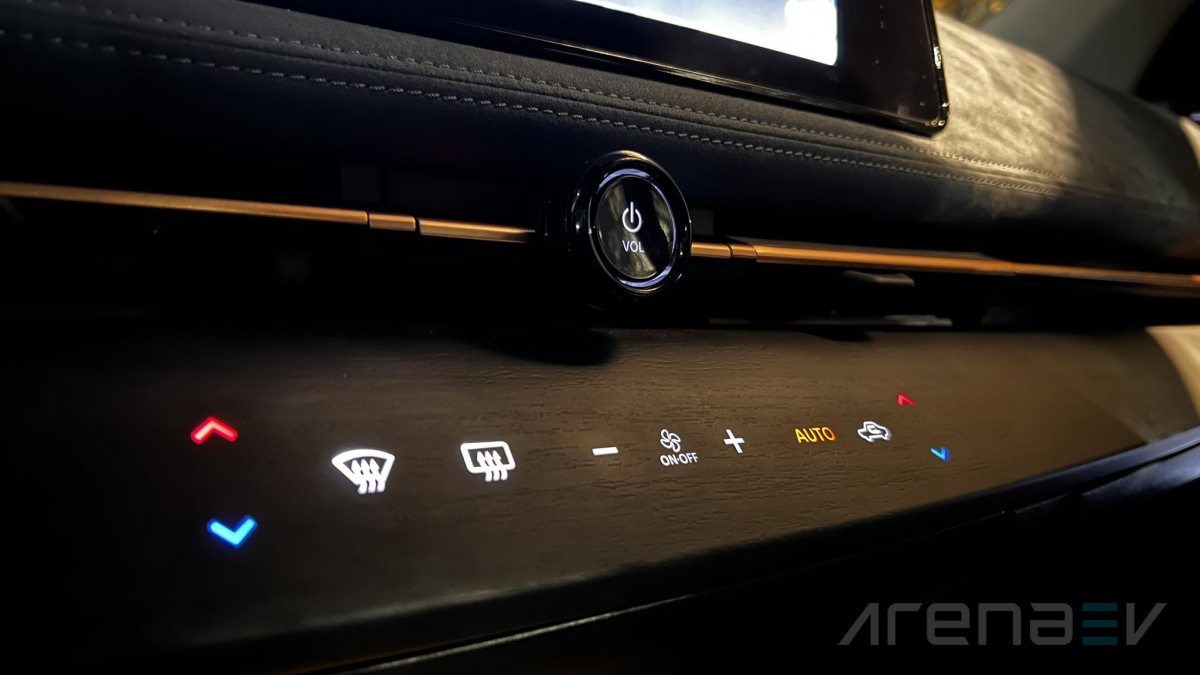
Moving further down in the middle, we find probably the most bizarre feature of any car we’ve tested yet. A big power-operated storage area, well hidden and unlabeled. This is without a doubt the perfect spot to hide stuff you don’t want anyone to find out. It can be opened by pressing a button in the center console and even has a fake floor, just like the suitcases in gangster movies.
Speaking of the center console, it is also extremely quirky. There is a button that moves the whole unit forwards and backwards, allowing you to have more storage room in front or more legroom in the back.

The shifter is also mounted here, surrounded by buttons for controlling the drive modes, said hidden storage area and the parking assist. They are once again mounted on a piece of wood and are not traditional buttons.
In the same vicinity we see the cupholders and an armrest, which contains the wireless charging spot and a small storage compartment, since most of the space inside the console itself is taken up by electronics.
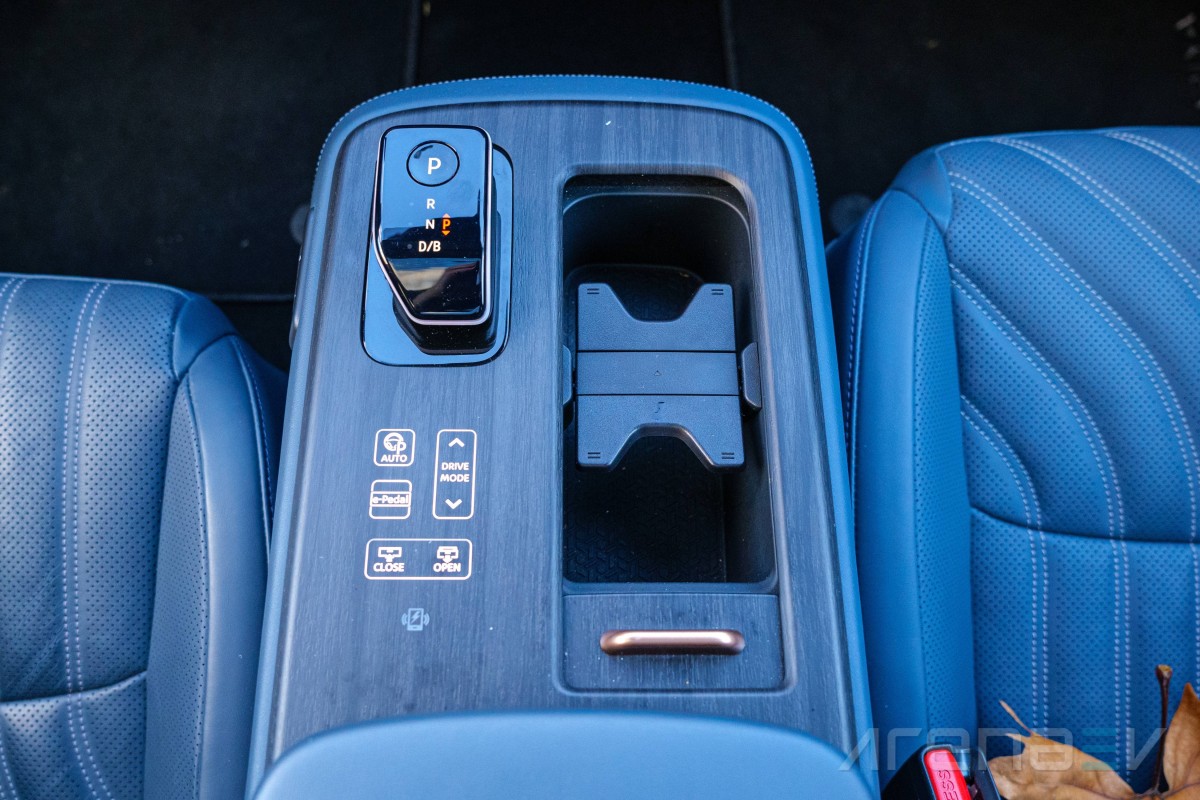
If you move the whole unit back, its lowest frontal part reveals another small pocket with three charging ports - USB-A, USB-C and a cigarette lighter are all available for your optimal convenience.
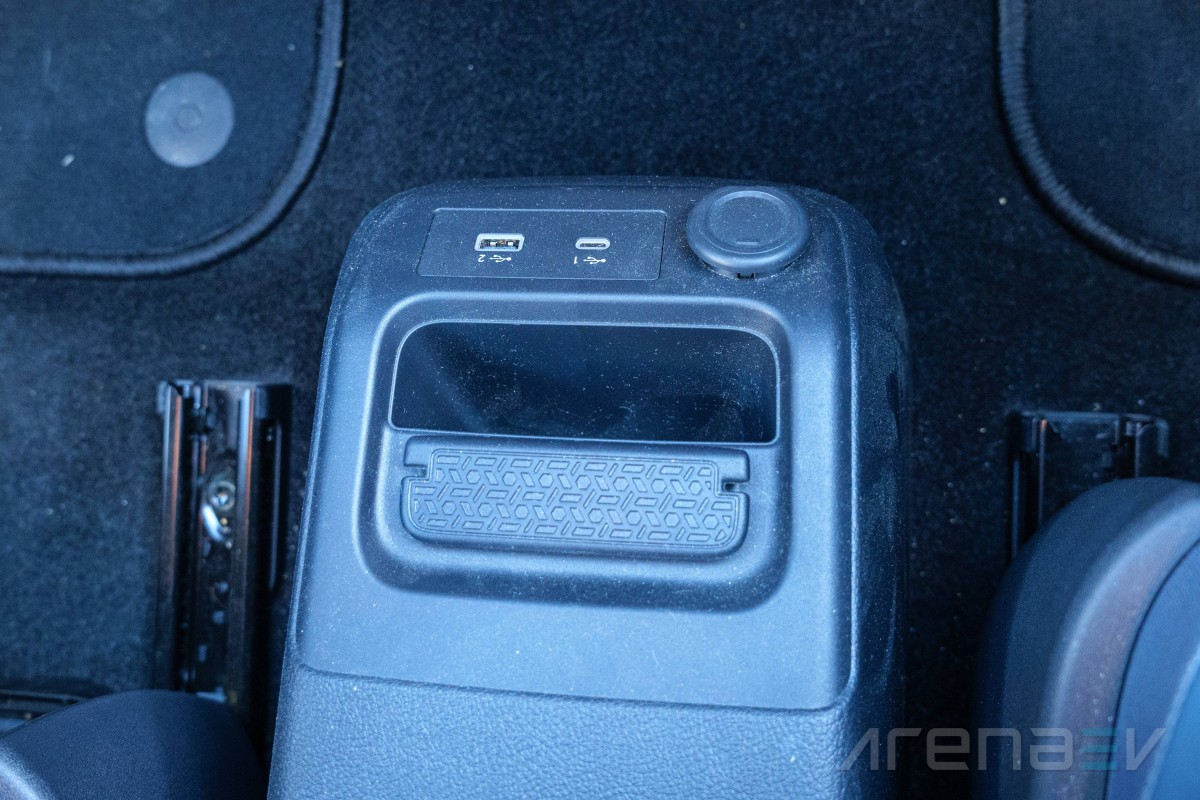
One of the few complaints about the Ariya's interior is that it’s really dark inside at night. We’re so used to ambient lighting in multiple flamboyant colors in new cars that the Nissan falls a bit short in that aspect. Except for the lantern lights and the screens, there is only a very thin strip of ambient light stretching from the door, through the deepest part of the dashboard through the other door and that’s it.
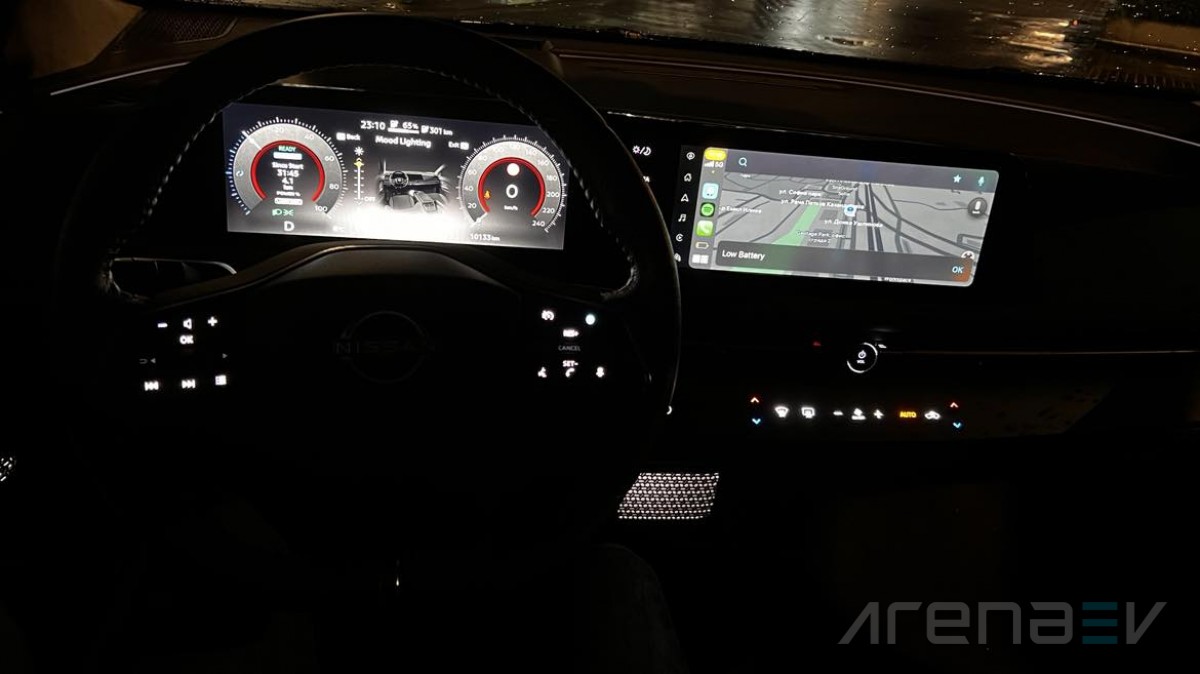
Moving to the back row we find a slight decline in terms of material choice, but the conveniences remain remarkable for the segment. You get heated seats and charge ports for the rear passengers, as well as the same soft blue leather.
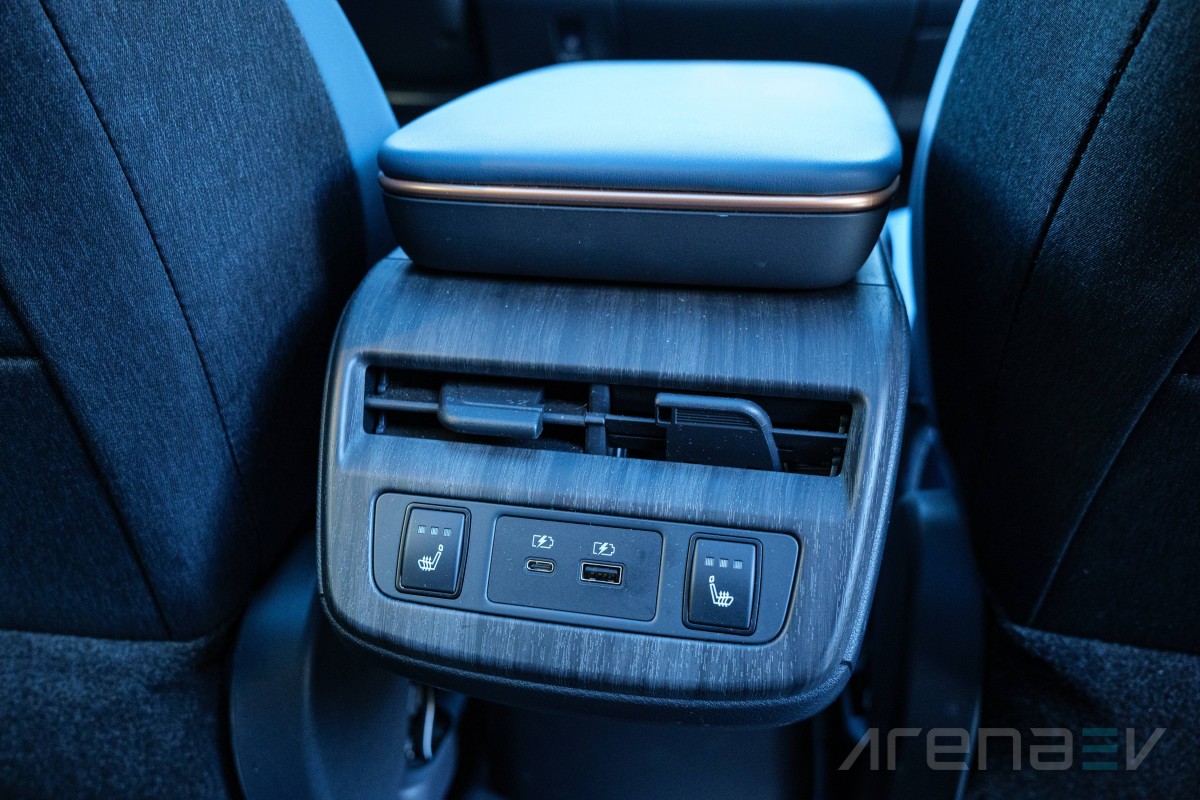
The doors, however. are made with harder plastics and the lantern lights from the front look like they are present, but only a part of them lights up. A great touch is that even the latch for dropping the rear seats is covered in leather.
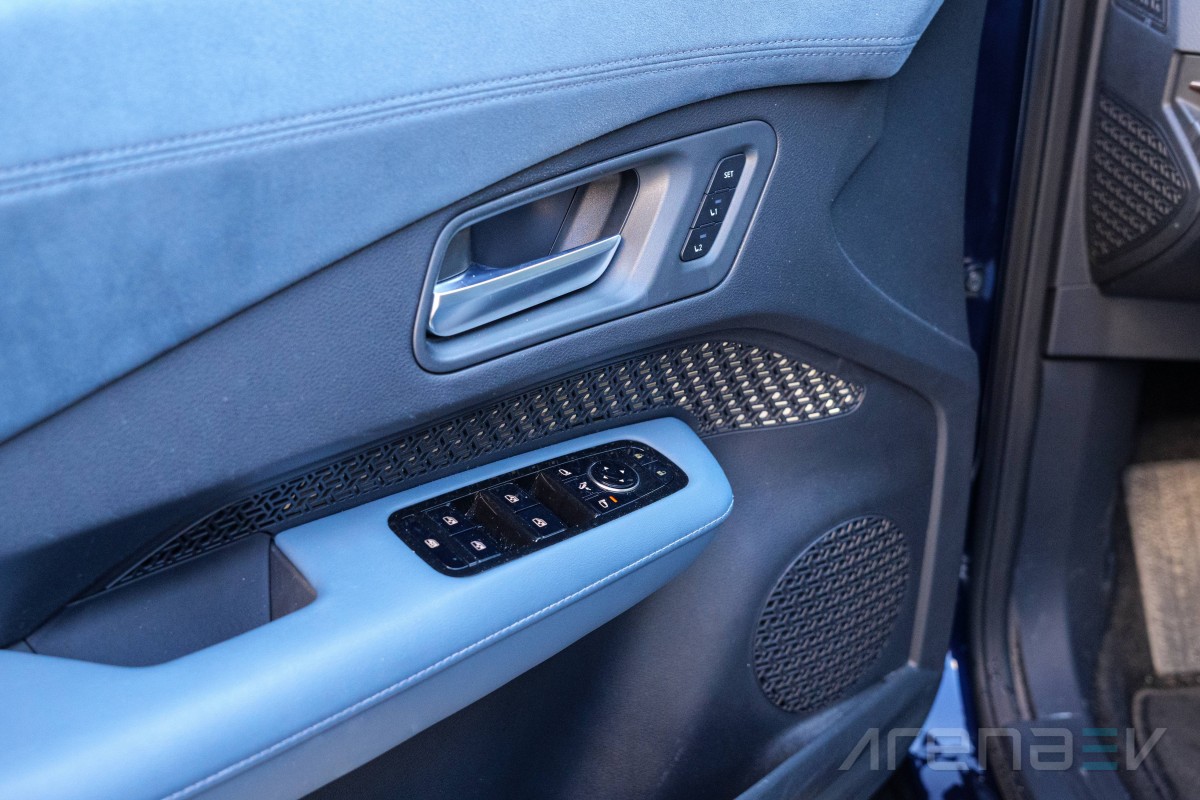
The Ariya also delivers, when it comes to space in the back. Our reviewer is 1.95 m (6’4”) tall and fits comfortably. There is more legroom than headroom, due to the sloping roof line, but it is nowhere near cramped. Also commendable is that the seats sit higher off the ground, allowing you to get into a more comfortable position, without your thighs being raised in the air.

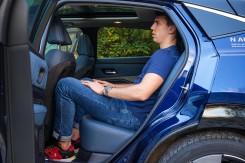

The Nissan Ariya offers just the right amount of space for comfortable travel in the back seats.
Storage & practicalities
When it comes to practicality, Nissan Ariya does really well. With its 16.5 ft³ of trunk space and 59.7 ft³ with the seats folded down, the crossover can fit a lot of luggage. These are not exceptional figures for the segment, but are on the correct side of practical.
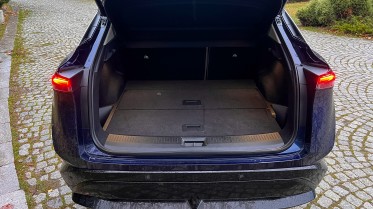
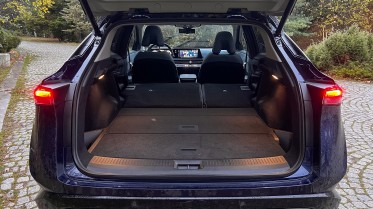
The Ariya has generous amounts of trunk space for the class, especially with the backseats down.
You also get a few storage pockets and a fake floor for better usability. These, combined with the many storage areas inside the cabin make the Ariya a great daily companion.
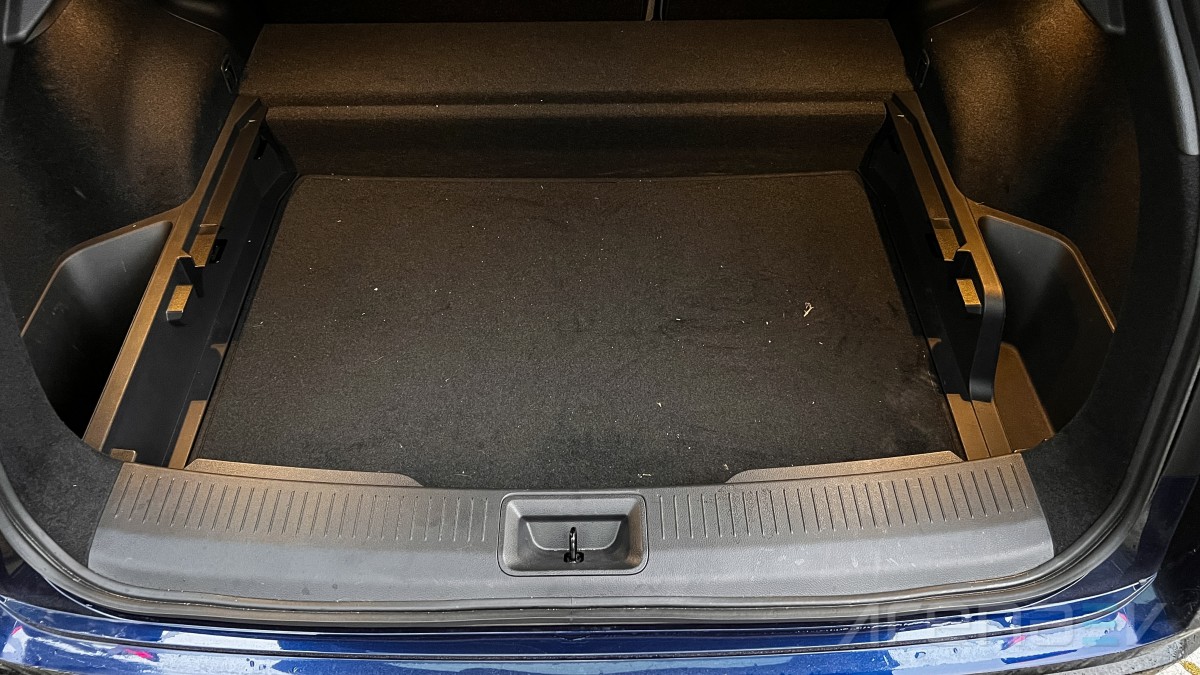
Sadly, Nissan deprived the Ariya off a frunk (front trunk). The place there is filled with electrical components so you can't store anything there.
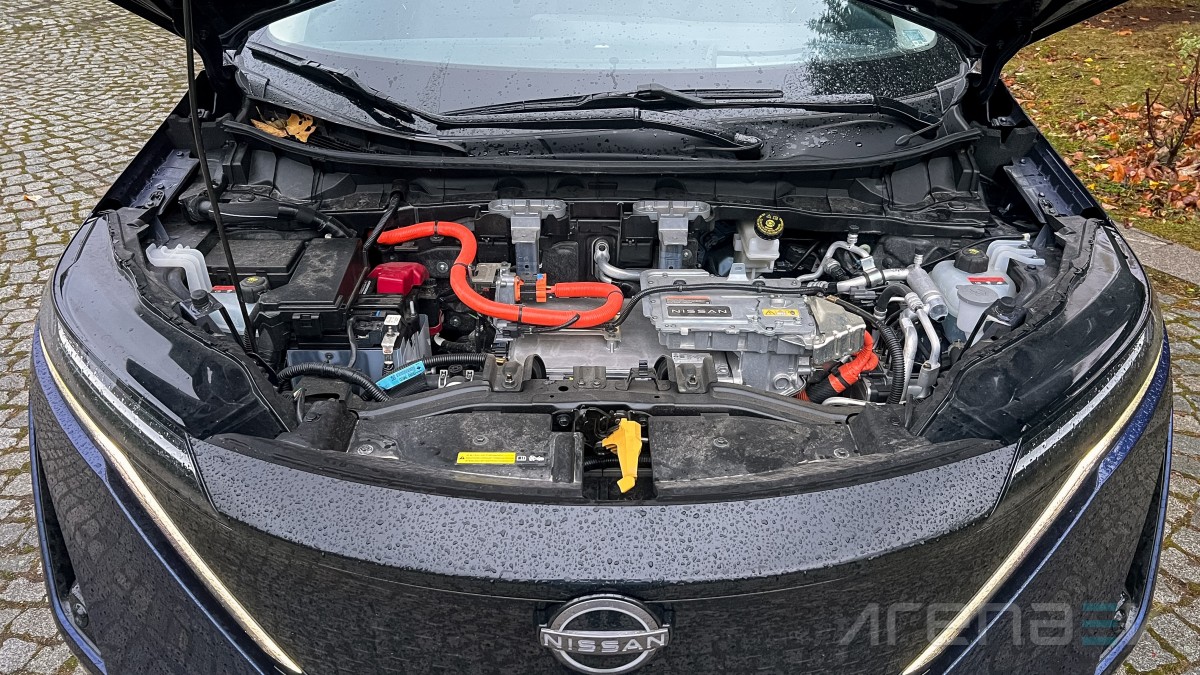
Driving experience
Driving the Ariya is as exciting as driving a FWD crossover can be. Which is to say it will get you places with zero to none driver engagement or excitement. The steering is vague with no real road feedback, but the wheel is very light. This makes it predictable and easy, which is just right for the purpose of being a daily driver and a great city companion.
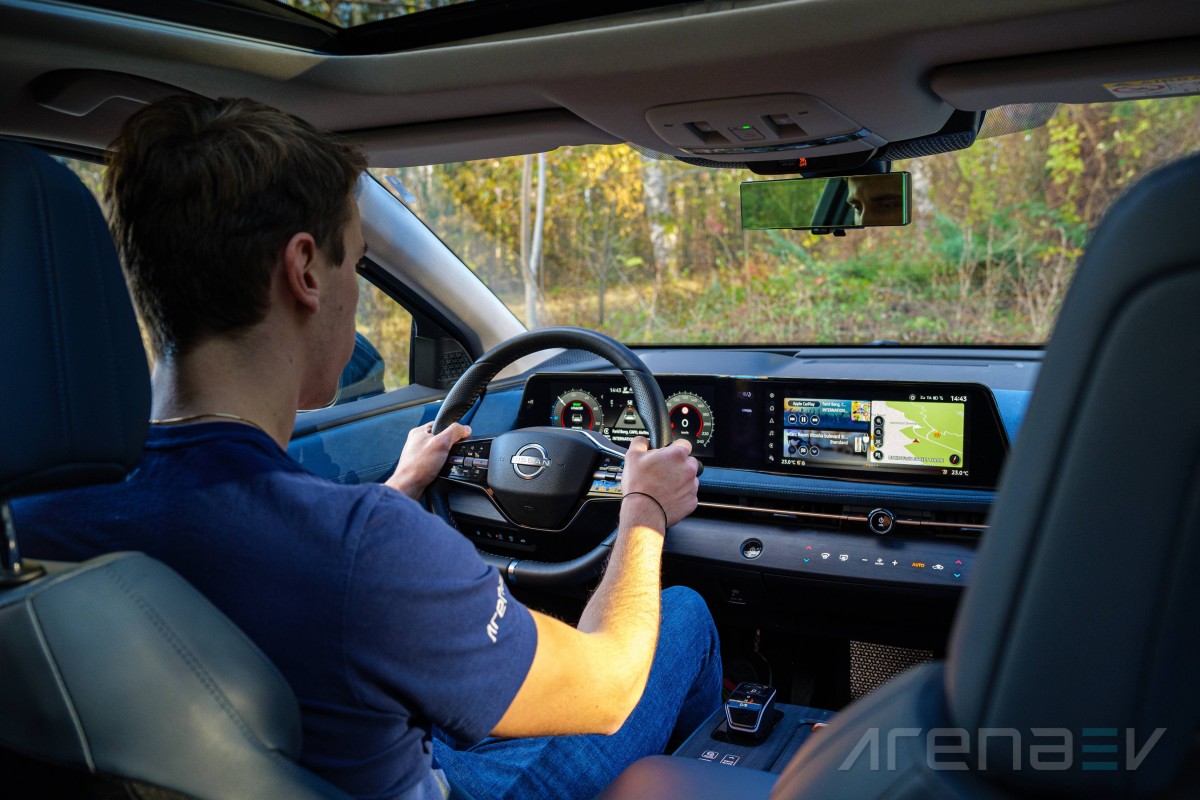
A missed opportunity to make it even a better daily driver is the absence of proper one-pedal driving, meaning you need to press the brake pedal for the Ariya to stop completely.
The suspension is on the softer side, though big potholes and bumps can be felt inside. On backroads you feel the chassis twisting significantly, but on the highway the Ariya stays planted to the road due to its huge weight of 4,676 lb.
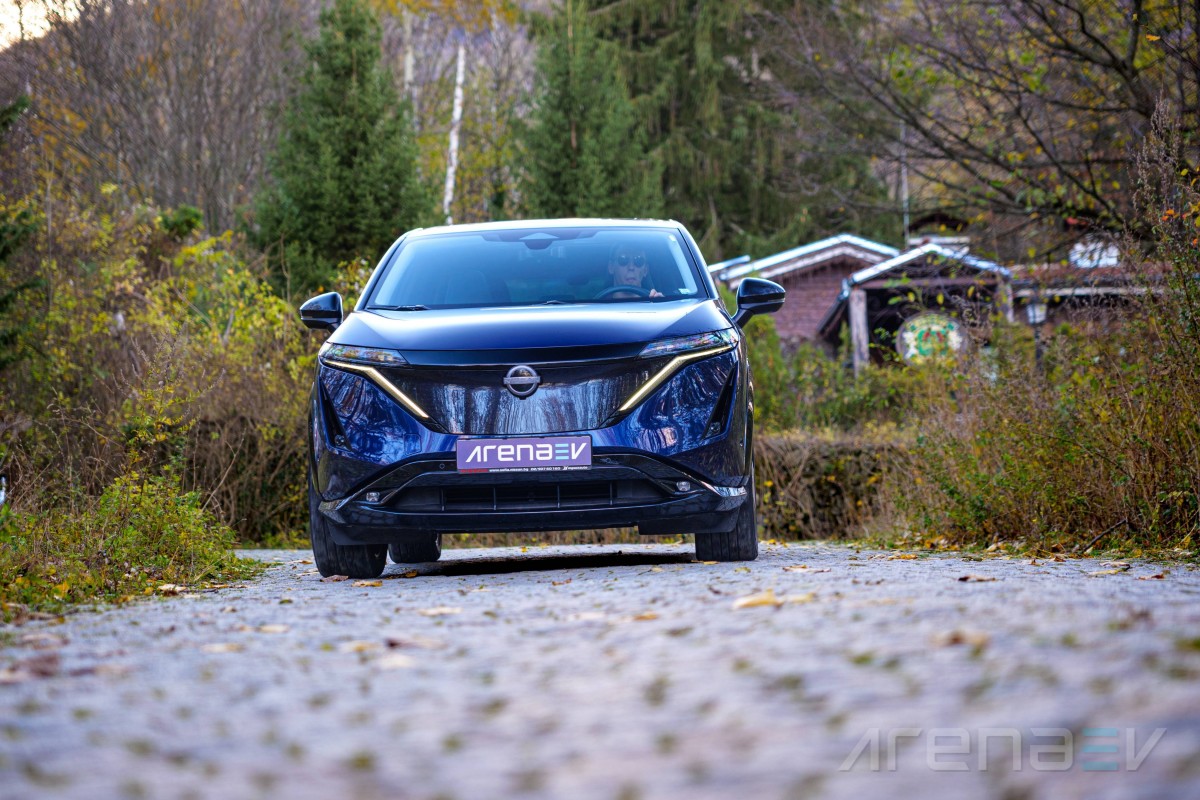
The Ariya is not a very maneuverable vehicle, which is probably its main shortcoming when it comes to city driving and tight parking situations. Thankfully the camera system works well and you are always aware of your surroundings.
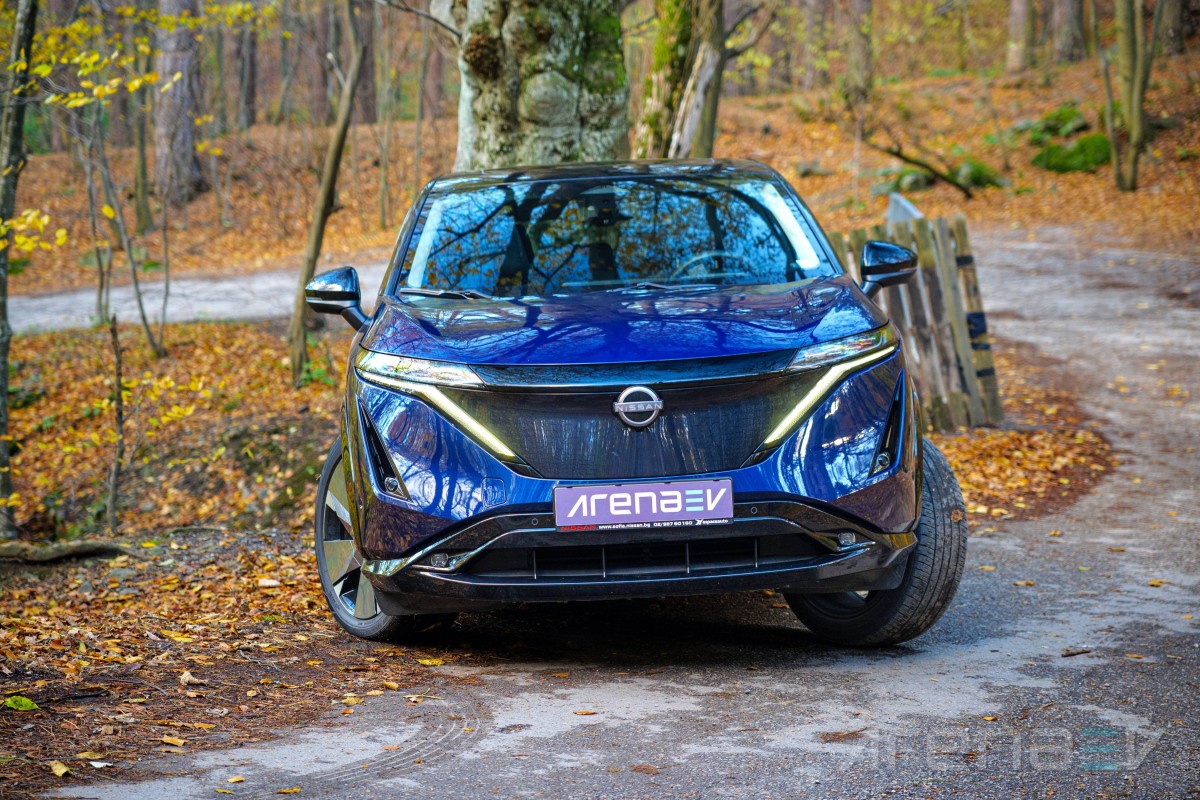
The driver aids are a little bit too paranoid in the Ariya and engage very early on, especially the forward collision system. Luckily, you can turn them off easily if you wish. An awesome driver assistance is the augmented reality in the head-up display, which draws the upcoming corner, so that you can better prepare for it and turn as smoothly as possible. It is definitely a gimmick, but we like it and it give the Ariya an edge over other family crossovers.
Tech features
When it comes to technology, the Ariya doesn’t reinvent the wheel. There are no insane new features, yet everything here works well. The only exception is the lag when you interact with the main infotainment screen - it's slow and unresponsive and overall below par for a modern EV.
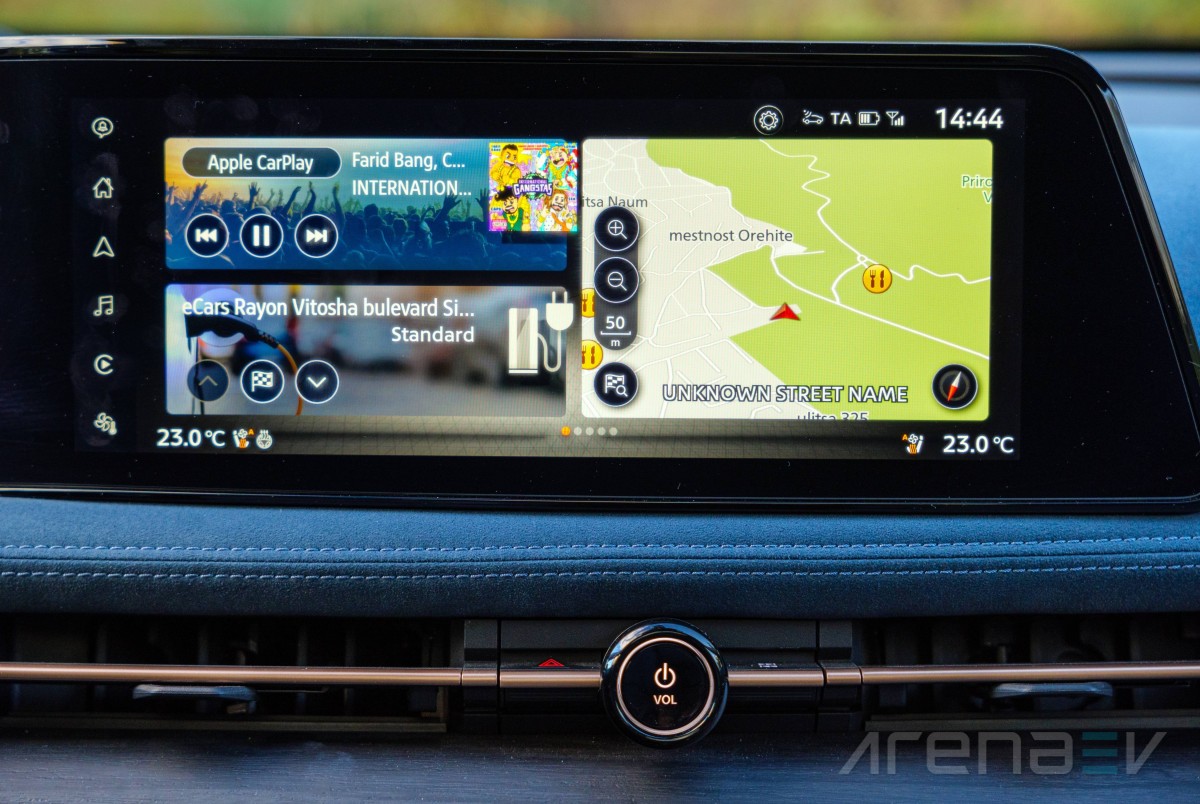
Performance of the screen itself aside, we appreciate the customizable menus, which make it easier for you to set your most frequently used options just as you’d like them to be.
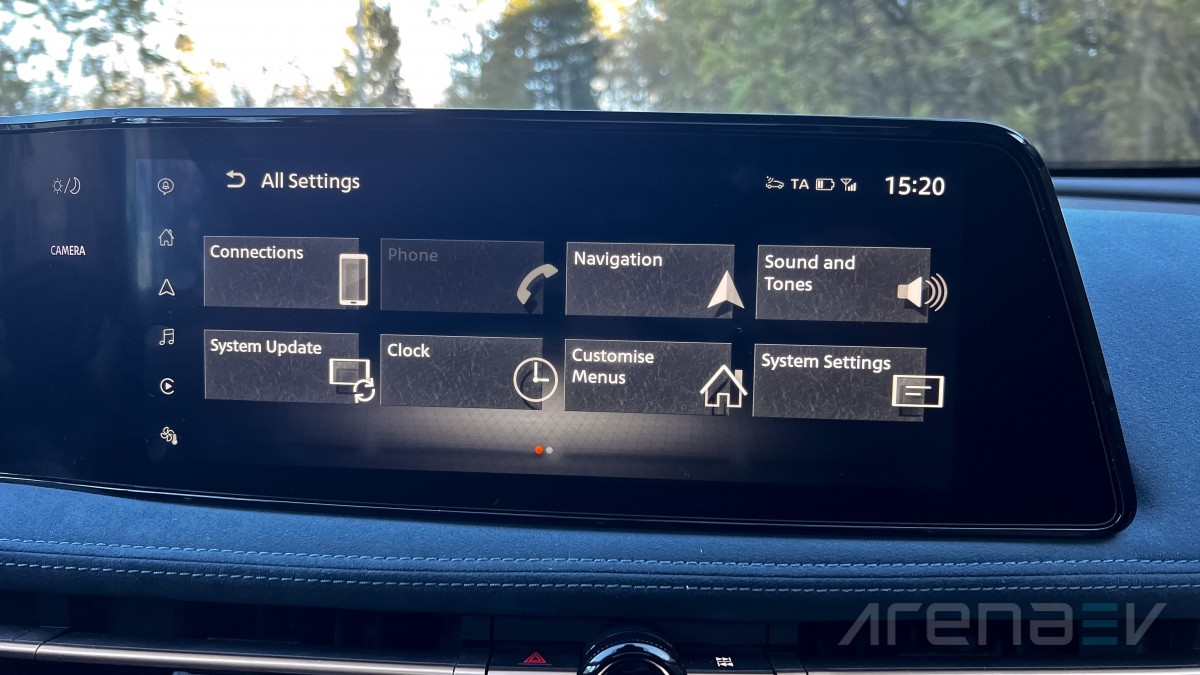
There are also connected services, which allow you to browse the internet, read the news, get live updates on traffic and over-the-air (OTA) updates for the software.
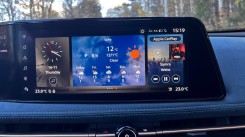
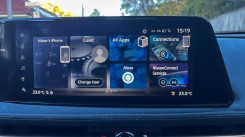

The infotainment screen in the Ariya is very useful, we just wish it was a little quicker to respond.
The most impressive bits are arguably the keys integrated into the wooden trim. Few manufacturers have ever done such a thing so far and this makes the whole interior feel upmarket and premium.
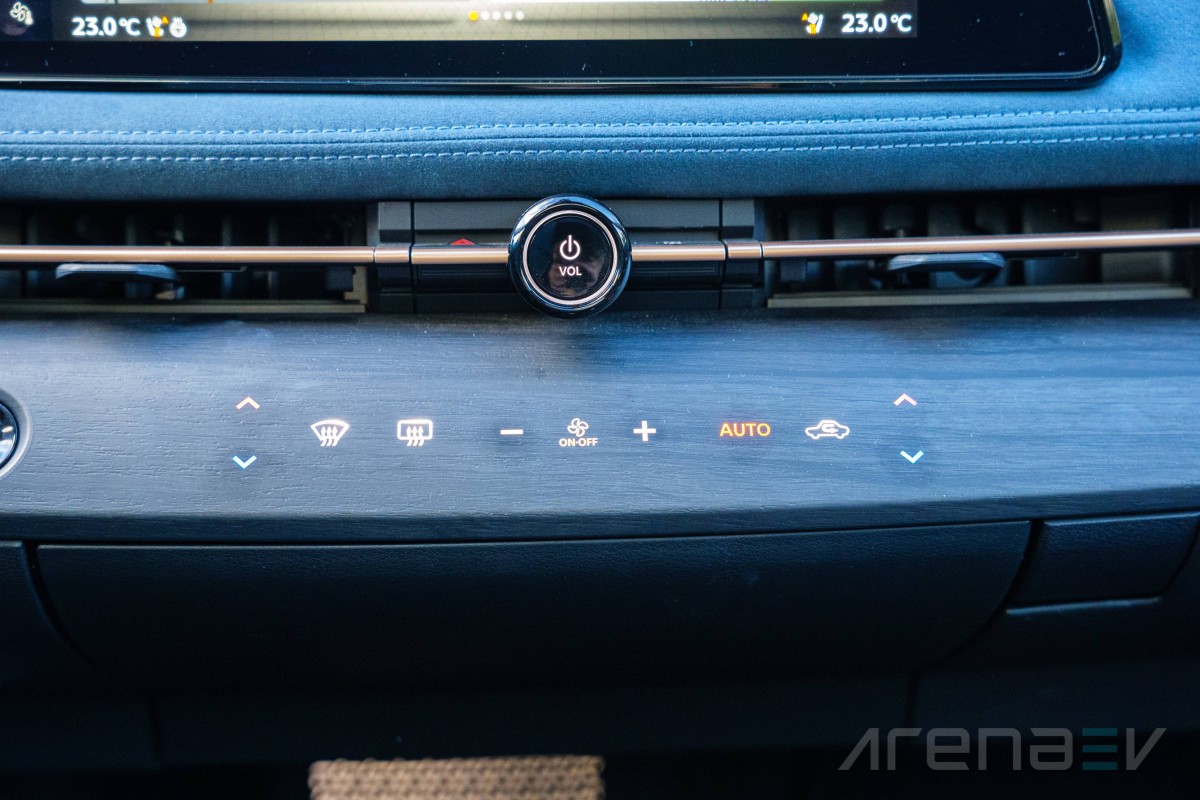
You also get automatic control for seat heating or cooling, depending on the A/C settings and external temperature. This is a nice perk, since operating those features manually requires multiple touches on the slow touchscreen.

You can switch between a regular rear-view mirror or a camera that does the same job in the Ariya with the push of a button. It sounds like a great concept and in some vehicles it is, but in this one the field of view is too narrow, which means you don't get full coverage. Still, it comes in convenient when you’re carrying a fully loaded trunk and cannot see anything through the rear window.
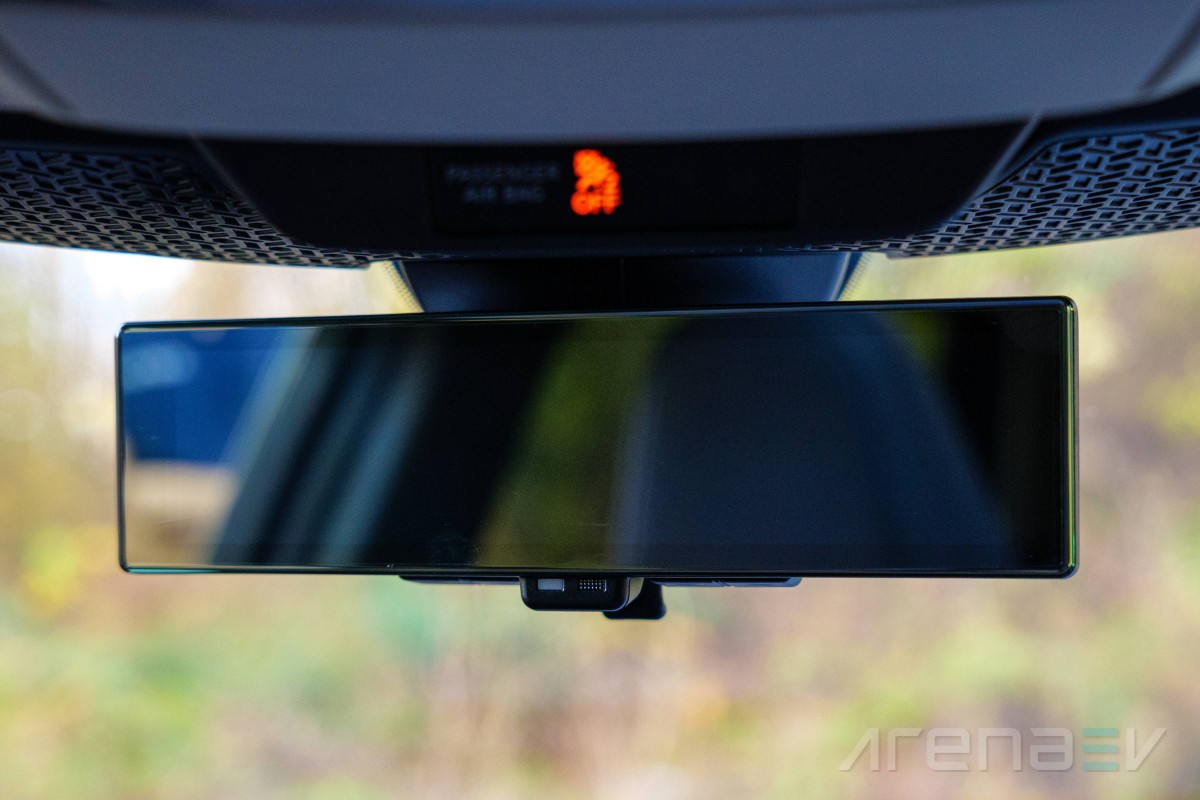
Ride comfort
The Ariya rides smoothly, without being excessively soft. It is a perfect balance that leaves you unbothered after every ride. There is no sportiness whatsoever, especially when it comes to handling in tight corners, but this is also not the reason one would get a FWD crossover in the first place.
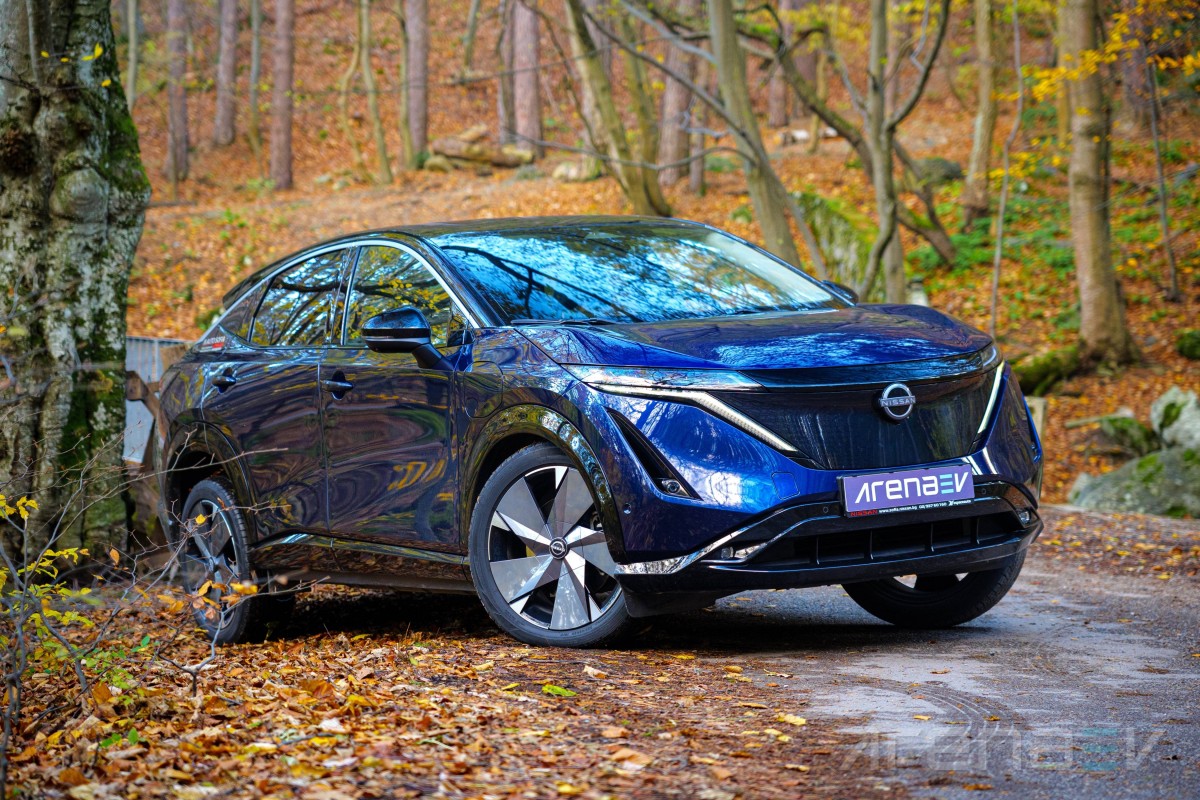
Cabin noise
A big positive of the high quality materials inside is that they absorb the ambient noises really well, resulting in a peaceful and calm atmosphere while driving. At low speeds the Nissan Ariya is quieter than a BMW i7 or a Mercedes-Benz EQS and that's really saying something.
The wind noise pushes is a few spots down the chart at 56 mph and beyond that the tires start reminding you of their existence, but the Ariya's interior remains peaceful at every speed.
Sound level tests are carried out with a specialized sound level meter placed in the car's cupholders. The test is conducted with air conditioning and radio off and while maintaining a steady speed.
Acceleration and braking
The Nissan Ariya we tested is hardly a track car with its relatively tame 242 hp and FWD. Even in sport mode, with the optimal conditions, we struggled to achieve the 7.6s time 0 - 62 mph sprint time Nissan promises. The best we could do was 7.9 seconds and once the battery fell below 40% of charge, we tried again and the result was even more disappointing at 8.5 seconds.
The Ariya accelerates smoothly and without an instant push of power even in sport mode, which is good for comfort if absolutely boring. Still, it keeps up with traffic and doesn’t feel too slow. The top speed is 99 mph, which is one of the lowest around and further underlines that this is not a car that likes to be pushed too hard.
When it comes to stopping, though, the Ariya shined. Not only did it achieve the joint-shortest braking distance, but its was super consistent. We achieved the same figure 3 times in a row, which is commendable. Even though it weighs a lot and has regular brakes, the Ariya can be counted on to stop rapidly when asked.
Consumption
The range test results came out slgihtly disappointing. The big 87 kWh battery made us hopeful it will be a chart topper, but the Arya ends up among the “hungriest” vehicles we’ve ever tested.
Still it scored decent numbers and while the WLTP rating of 333 miles is a stretch, you can come close if you are gentle with the accelerator.
It should be noted that our testing was conducted at 52°F, which has a slightly negative effect, but is still not freezing weather. There was also no rain or wind, so the results are comparable.
We measure consumption by driving at constant speeds on an identical test route during the day. Testing is conducted with air conditioning, all safety systems and radio on. The data comes from the vehicle's board computer. Specific testing parameters such as ambient temperature are mentioned in the text on a case by case basis.
Charging speed
The Nissan Ariya is rated to charge at up to 130 kW, which we almost achieved in our testing. We preconditioned our battery and were able to get a maximum input of 128 kW. A very cool detail is that the chrging outlets are covered with beautiful button-like caps, which are not even present in more upmarket manufacturers like BMW or Mercedes.

Competition
The Nissan Ariya joins the most competitive segment in the automotive industry - that of the compact electric crossovers. It bets on a big battery, great build quality and insulation, combined with modern touches and quirky decisions. The result is a great end product, but one that also costs more than most of its rivals.
For the first and closest competitor we have chosen the Hyundai Ioniq 5 LR RWD. It is similar in size, but the Ioniq 5 is driven by its rear wheels, has better trunk size and also offers a frunk. It also does better in terms of consumption to negate the disadvantage of its small battery, but the Ariya offers a much better interior in terms of materials, build quality and has space for the rear passengers.
The second rival of the Ariya is the Mercedes EQB 250+. It is a little bit smaller, but also features FWD and more storage space, combined with a modern premium interior. The Mercedes has better brand image and a much more modern infotainment system, but severely lacks behind in terms of interior quality.
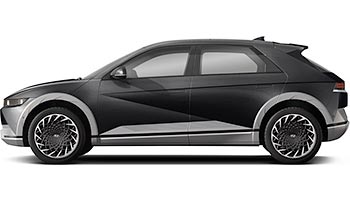
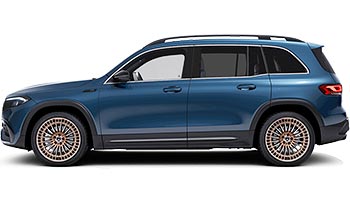
Hyundai Ioniq 5 LR RWD 2021 - • Mercedes EQB 250+ 2022 -
Verdict
The Nissan Ariya is a vehicle with a significant accent on comfort. It is a luxurious vehicle that isn’t bothered by sporty characteristics or 0-62 mph times - one that wants to carry you around in comfort and style.
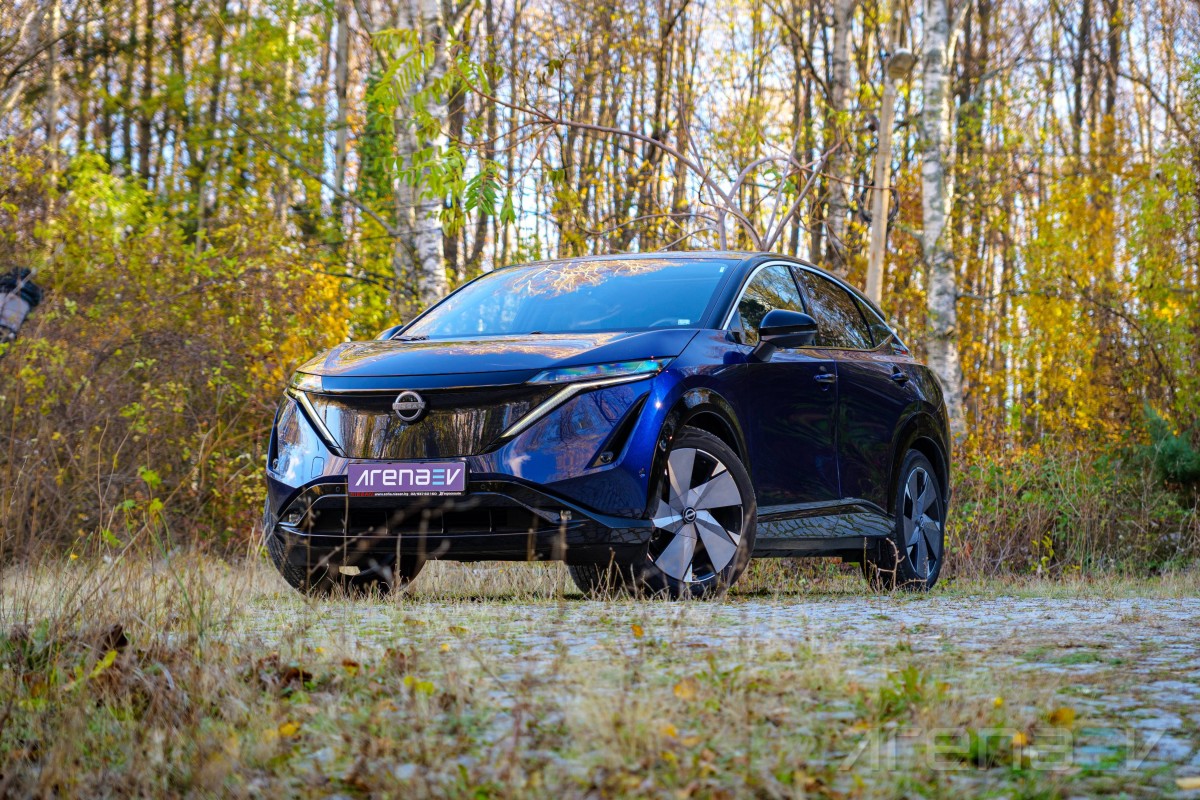
Its design is futuristic, but elegant. It has the modern coupe-like shape, but doesn't sacrifice headroom or storage space.
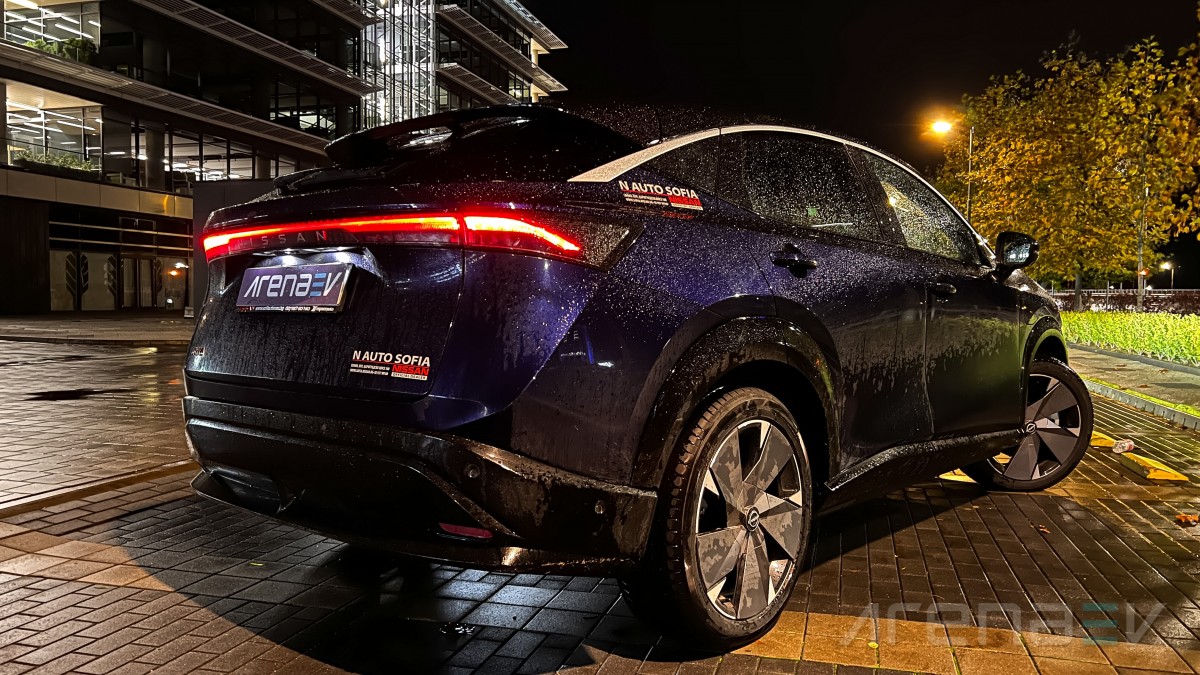
Sure, the Ariya is not the best when it comes to technology, especially the center display feels underpowered, but everything you get on-board works and is easy to use and can be configured to your specific needs and desires.
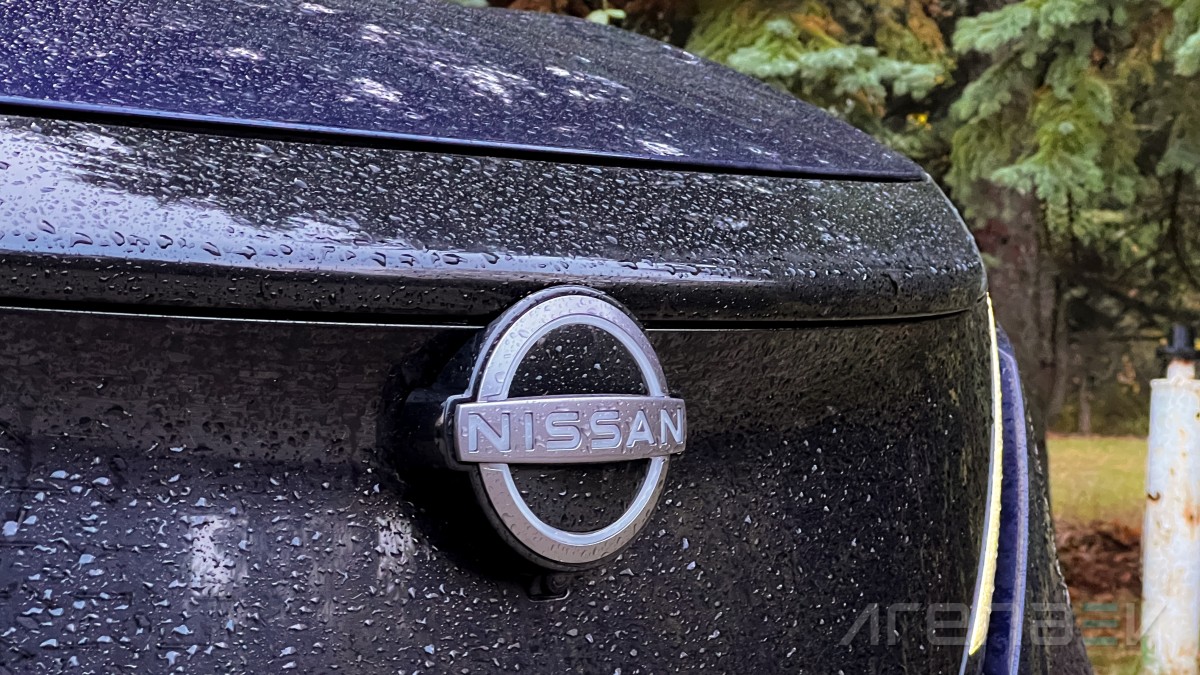
At the end of the day, this is a daily driver, which offers the relatively forgotten concept of luxury in small cars and this is exactly its strongest selling point. None of its competitors at this price point have even close to its attention to detail and while not everyone will feel the price premium is worth it we are extremely happy that some manufacturers are still so concerned about the quality of their product in an age where the software of a vehicle is its most important trait.
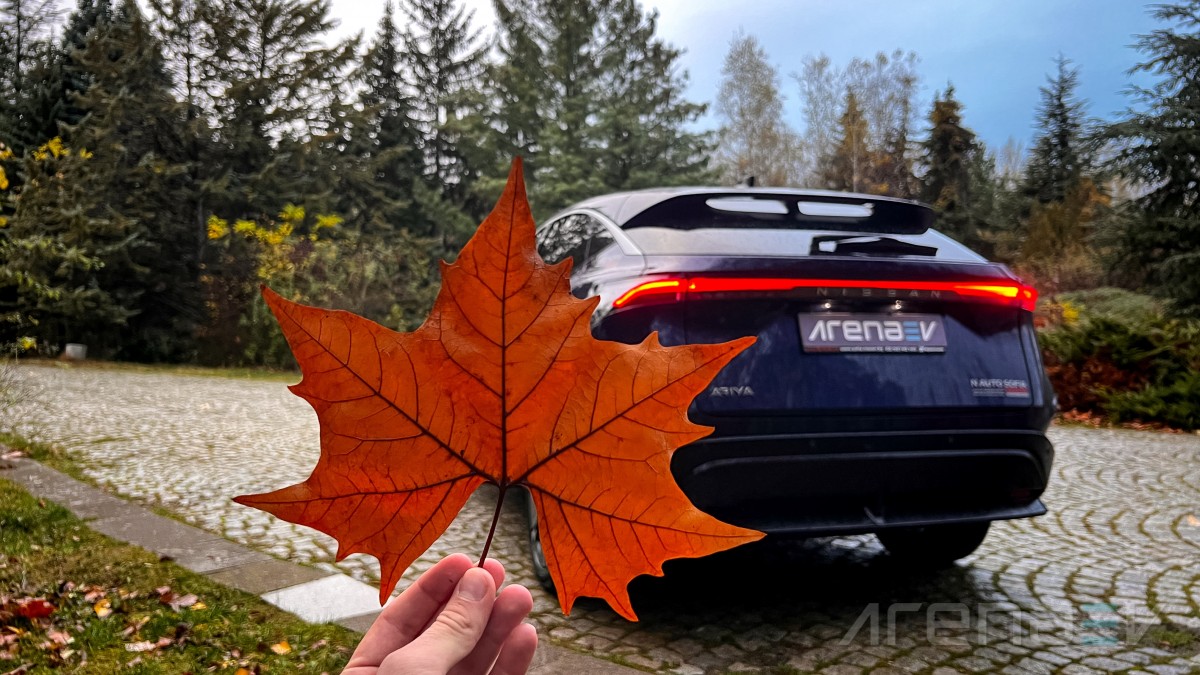
Pros
- Exceptionally quiet and insulated cabin.
- Amazing build and material quality.
- Roomy interior with lots of storage pockets.
- Sizeable trunk with foldable seats and many additional pockets.
- Futuristic, but not excessive styling.
- Highly customizable gauge cluster.
- Stable and easy to drive.
Cons
- Above average weight and high consumption for the class.
- The infotainment system is laggy.
- Lack of proper one-pedal driving.
- Dark interior at night.
Related
Reader comments
- Anonymous
Well, we did a thorough comparison in 2023 and it came down to Ariya, ID.4, EV6, and Ioniq 5/6, and my spreadsheet has them all about equal, with various pros and cons. We chose Ariya Evolve+, after re-test-driving them all, and noticing the contrast...
- 09 May 2024
- Iby
- Tom
In have the AWD. Like it a lot. Infotainment could be better, but luckily this car supports OTA updates.
- 13 Feb 2024
- J8y
Not bad at all, if this car was released in 2017, it would be an OK pick for some who wants a bland EV SUV. In this day it feels ancient, better than prehistoric Leaf with no battery management, but still utterly laughable.
- 02 Dec 2023
- dNZ
